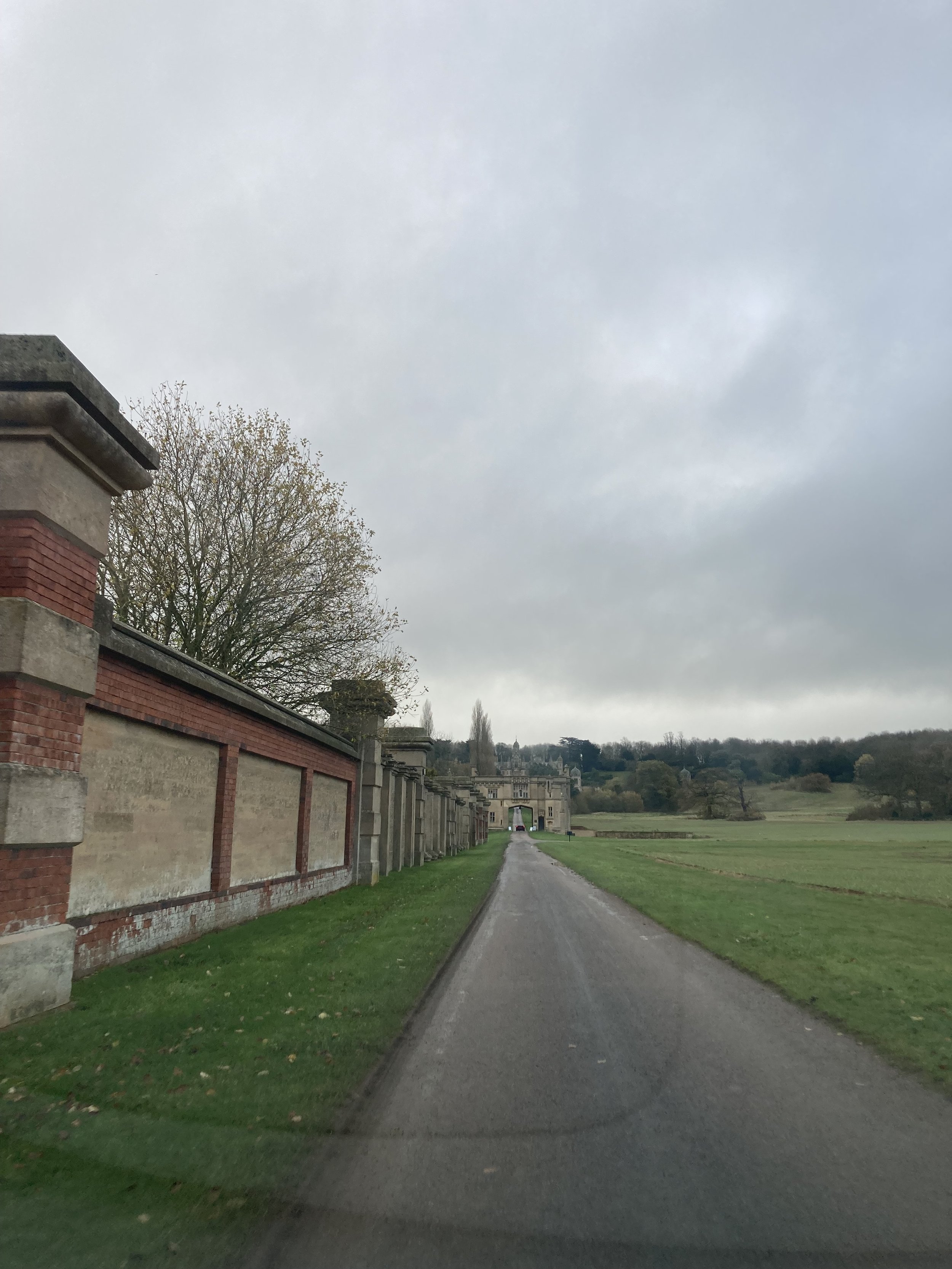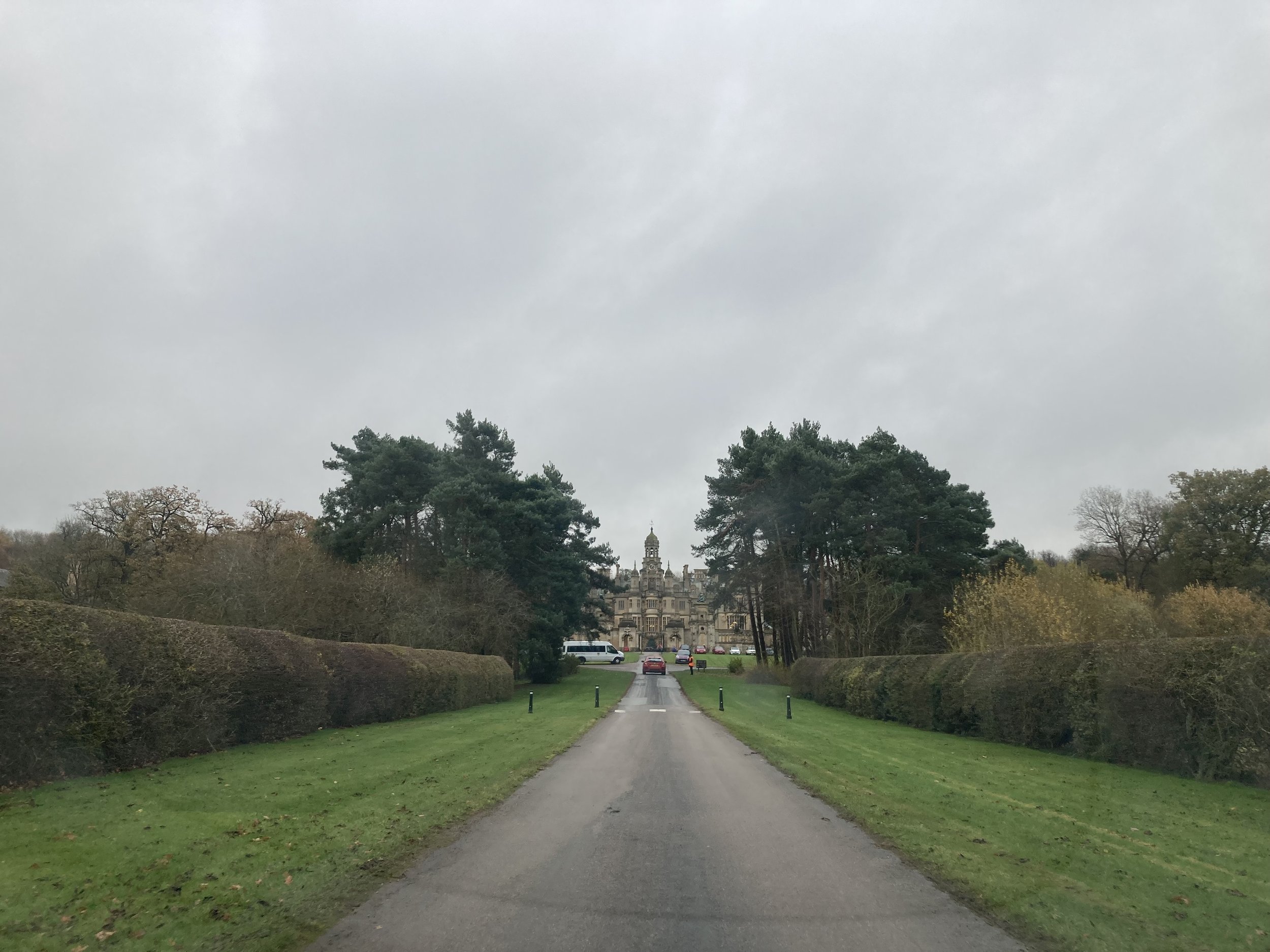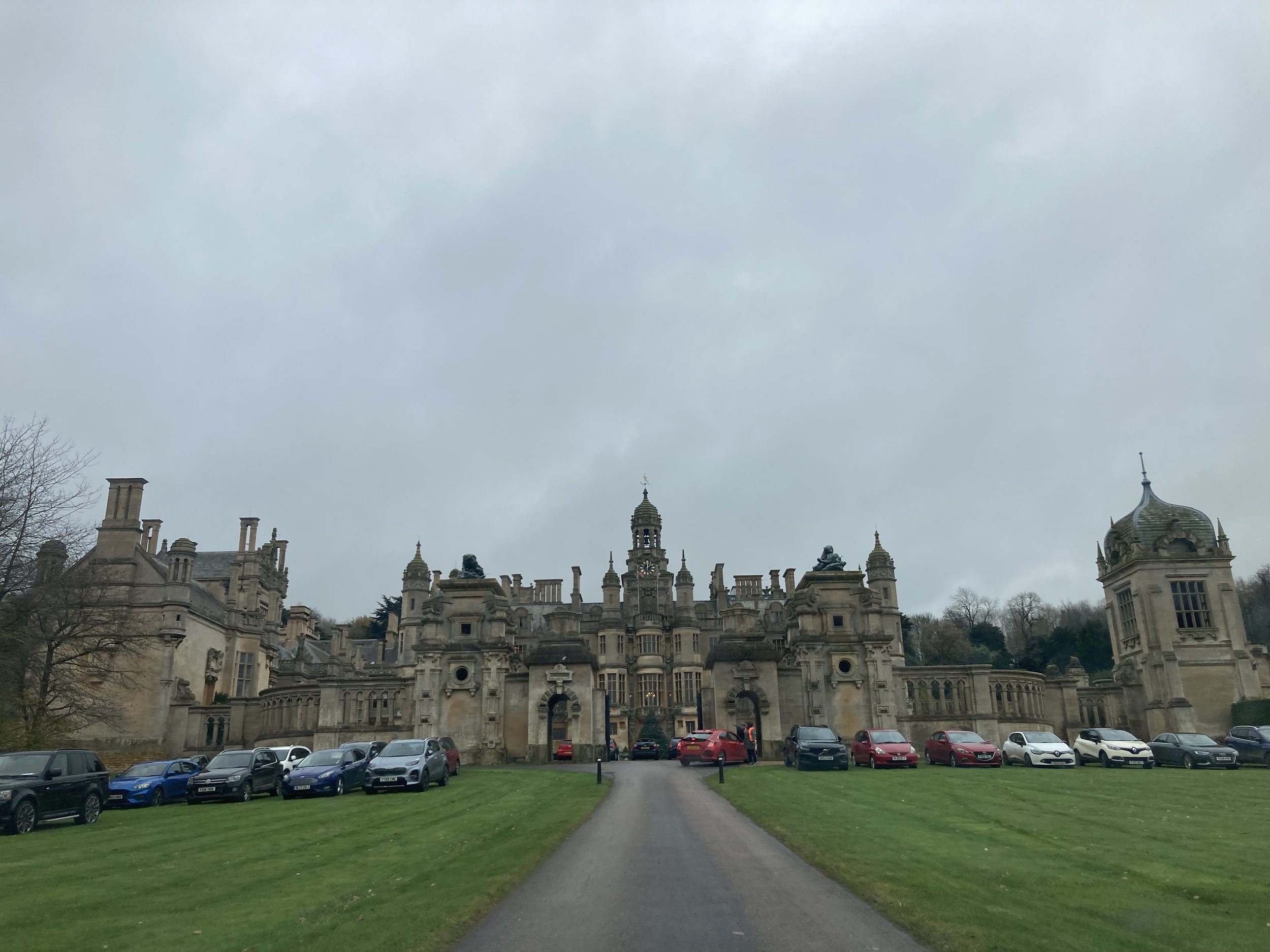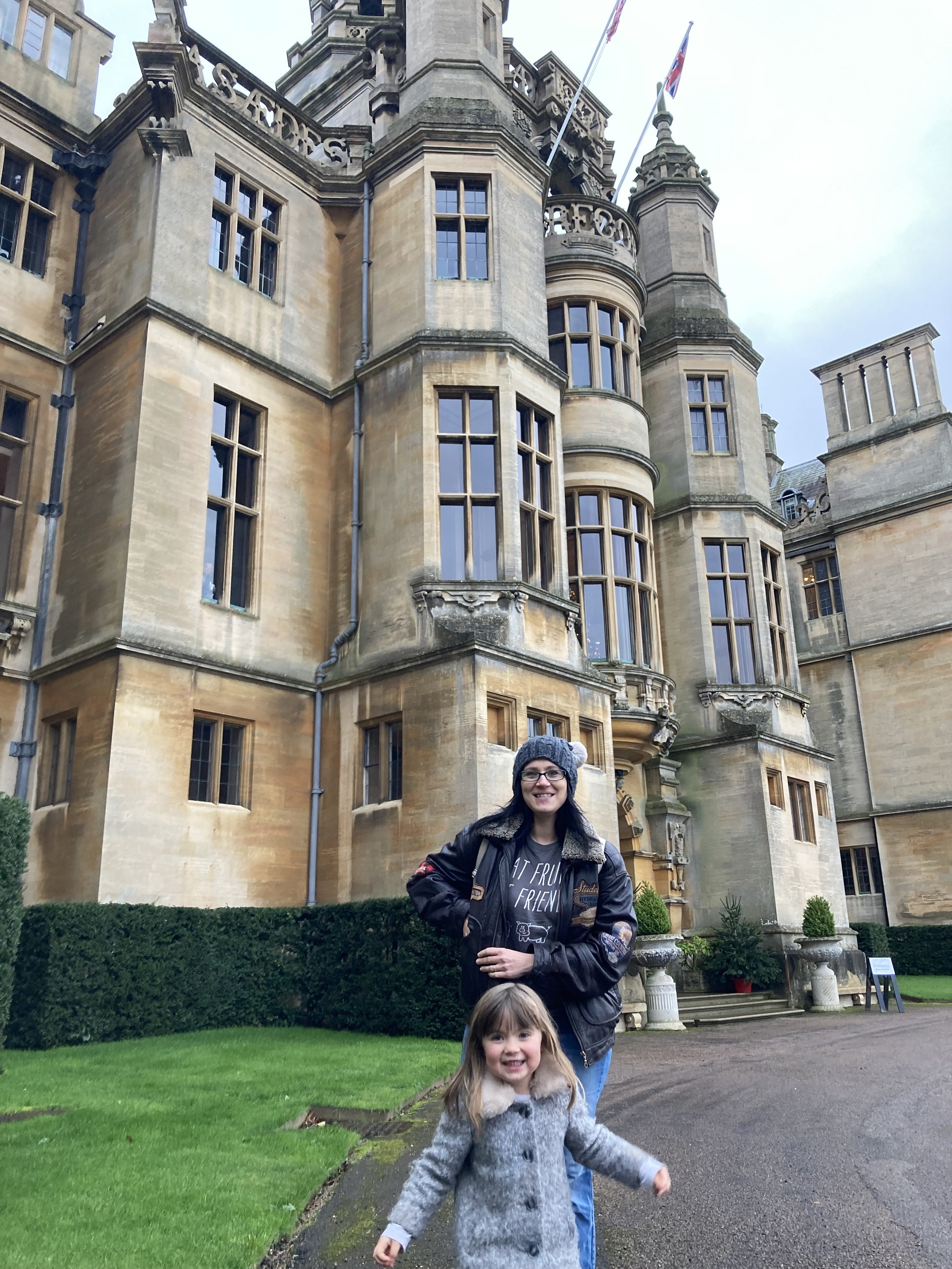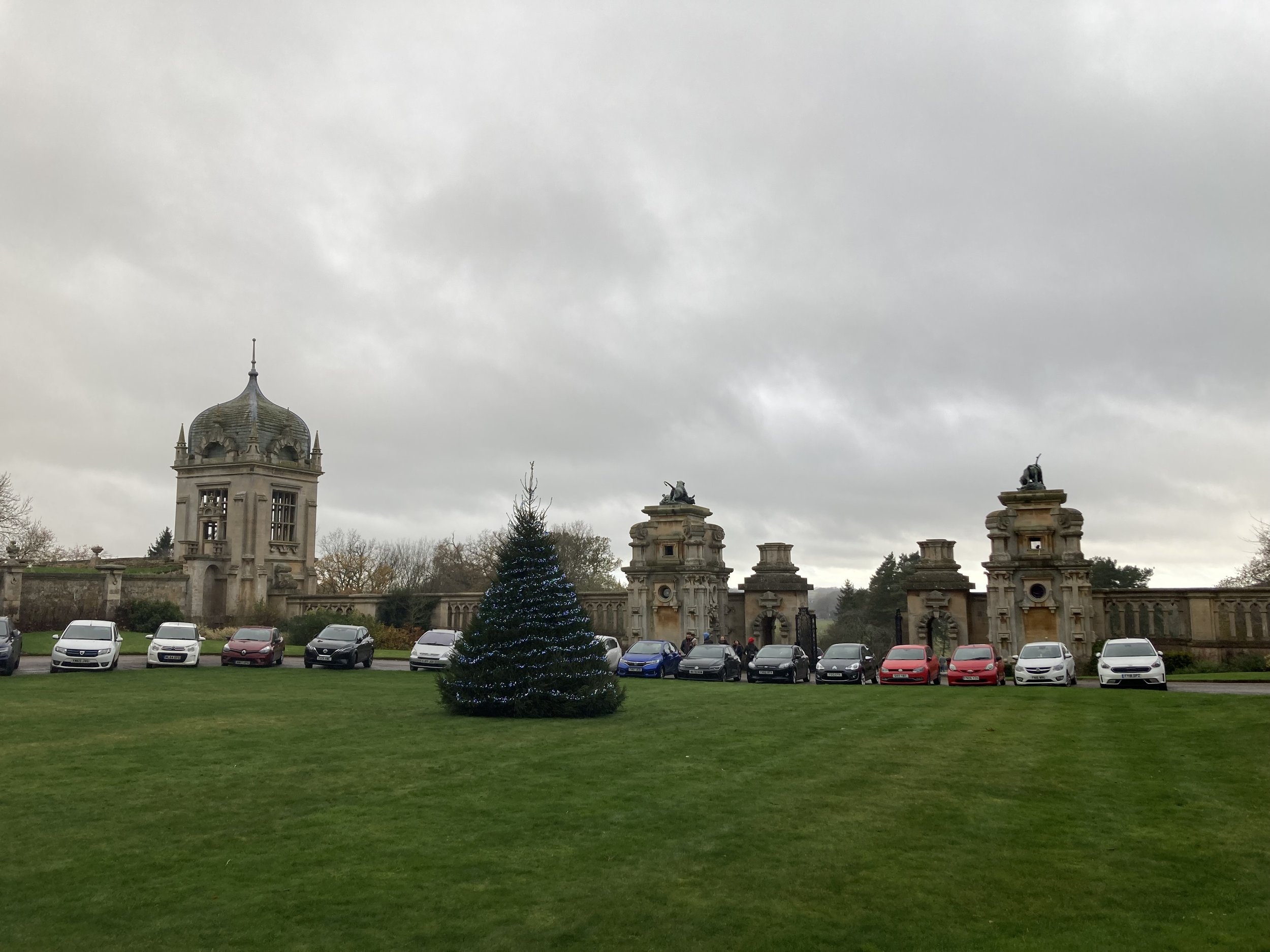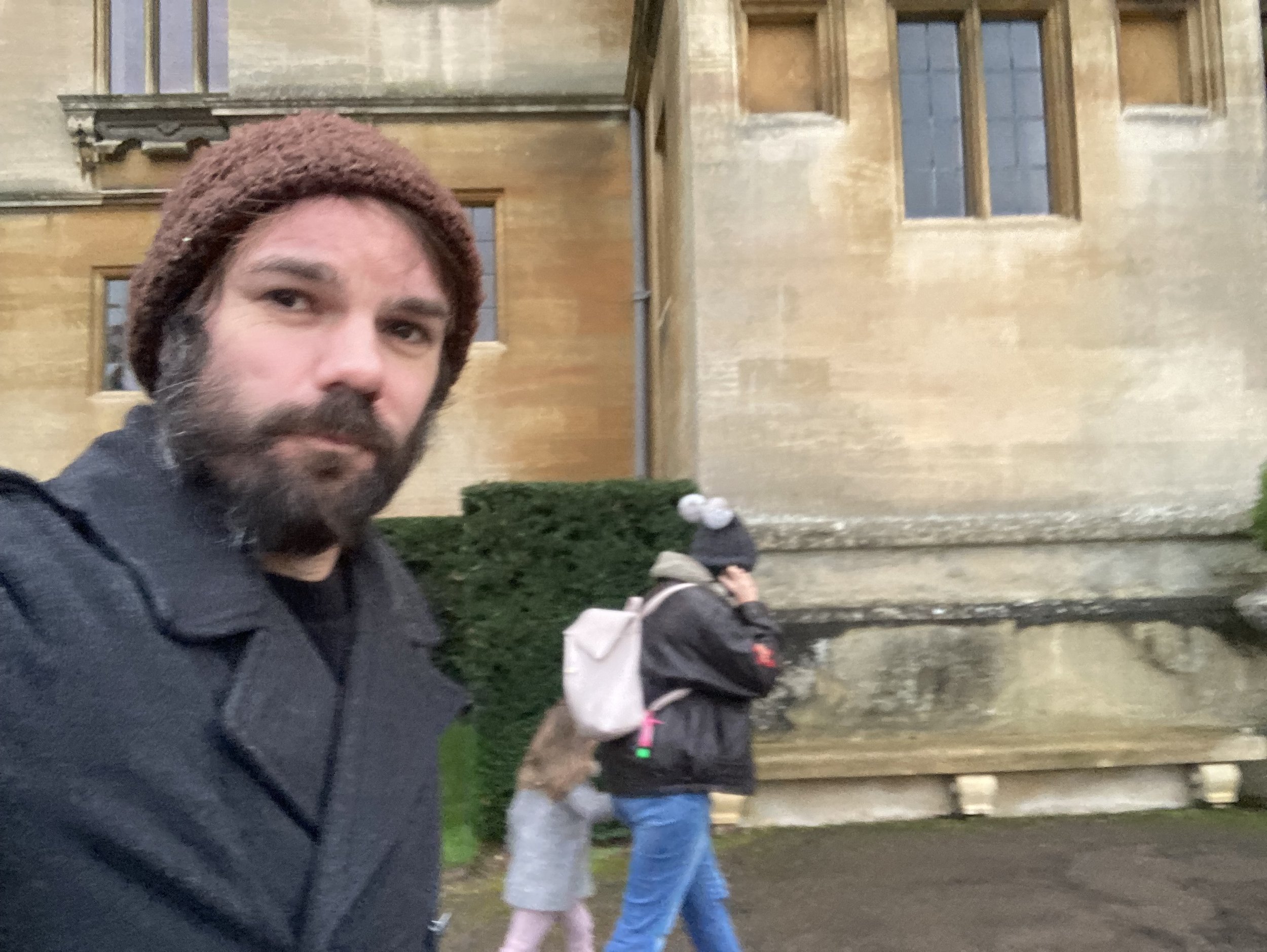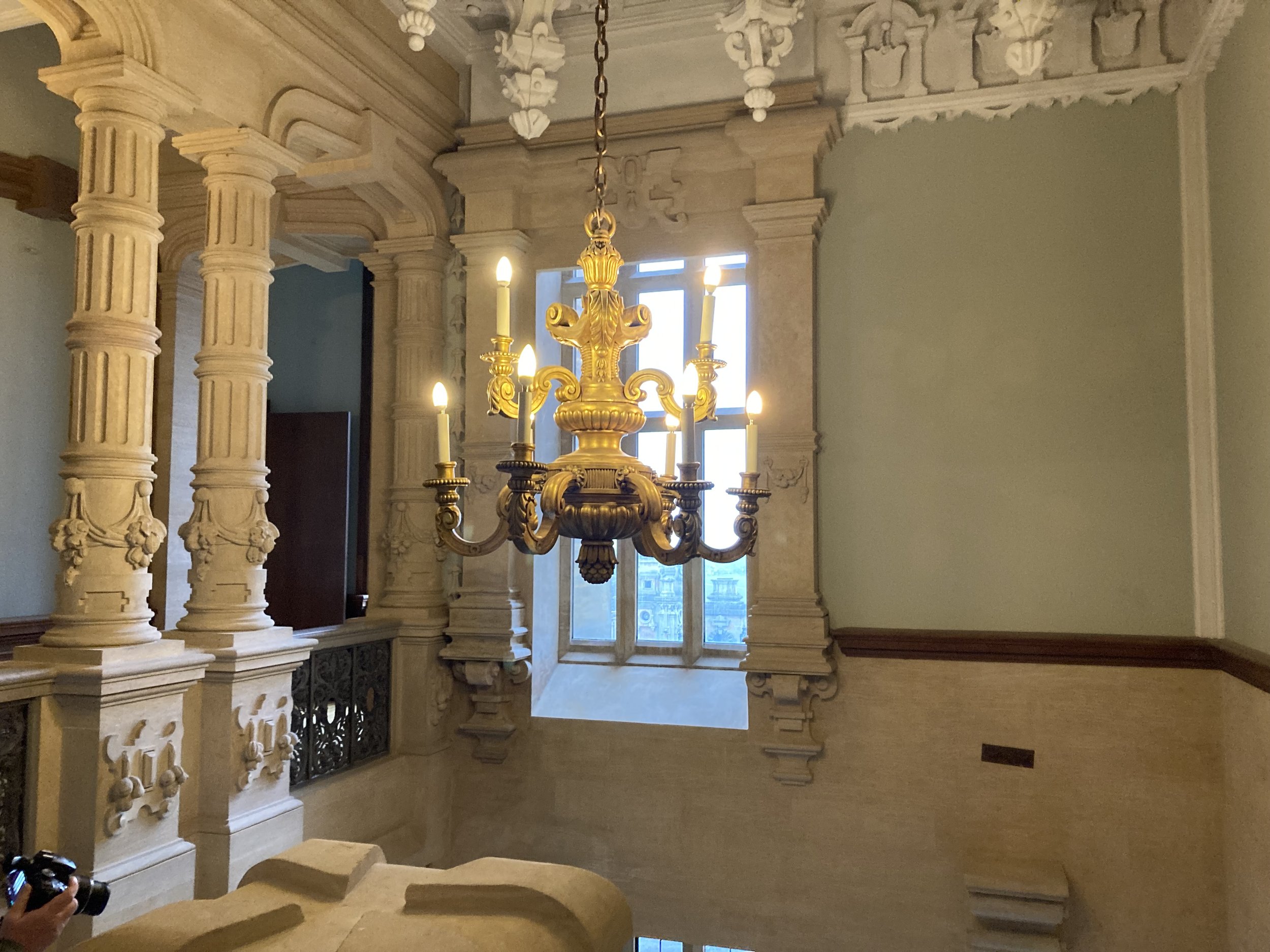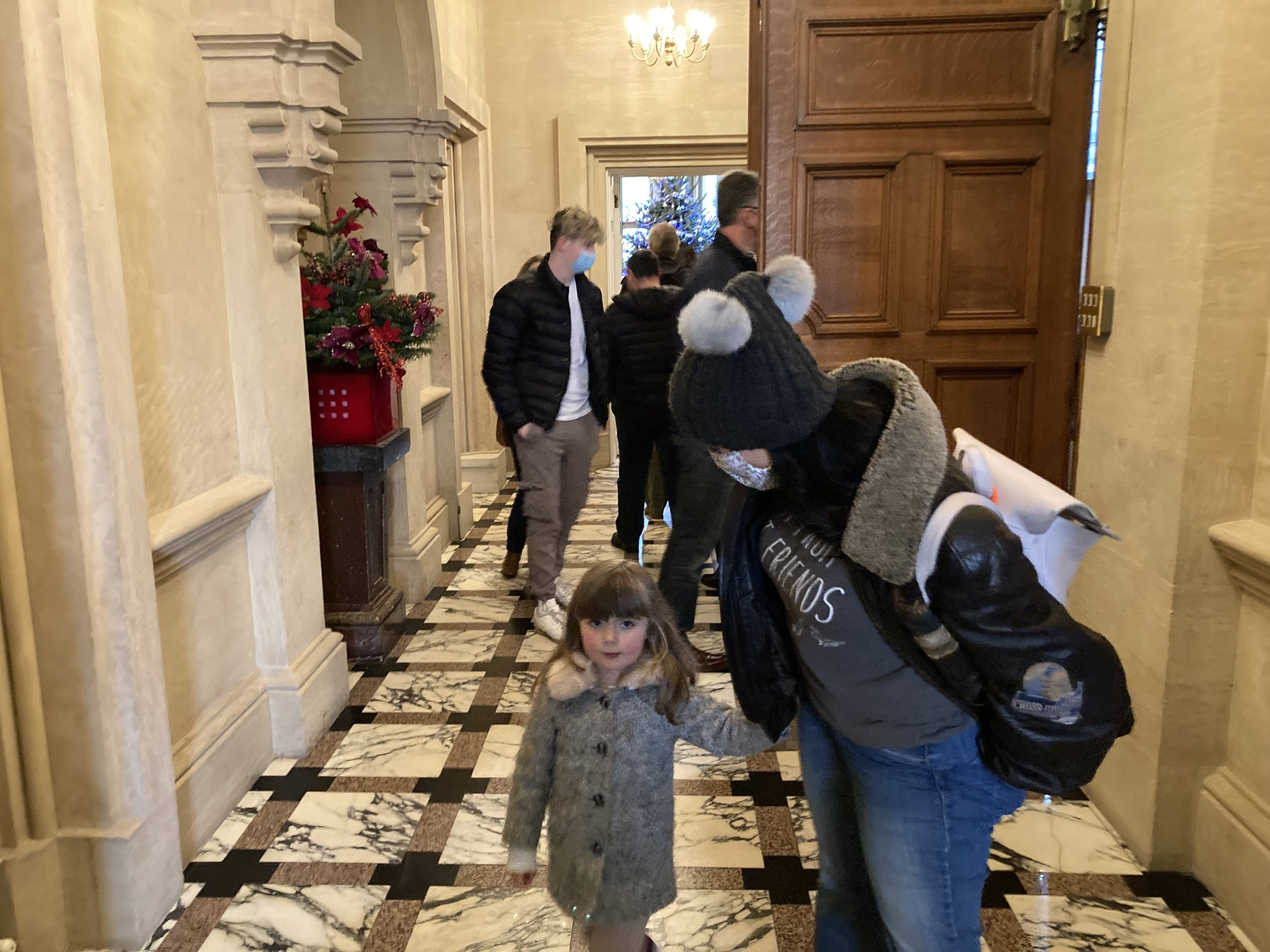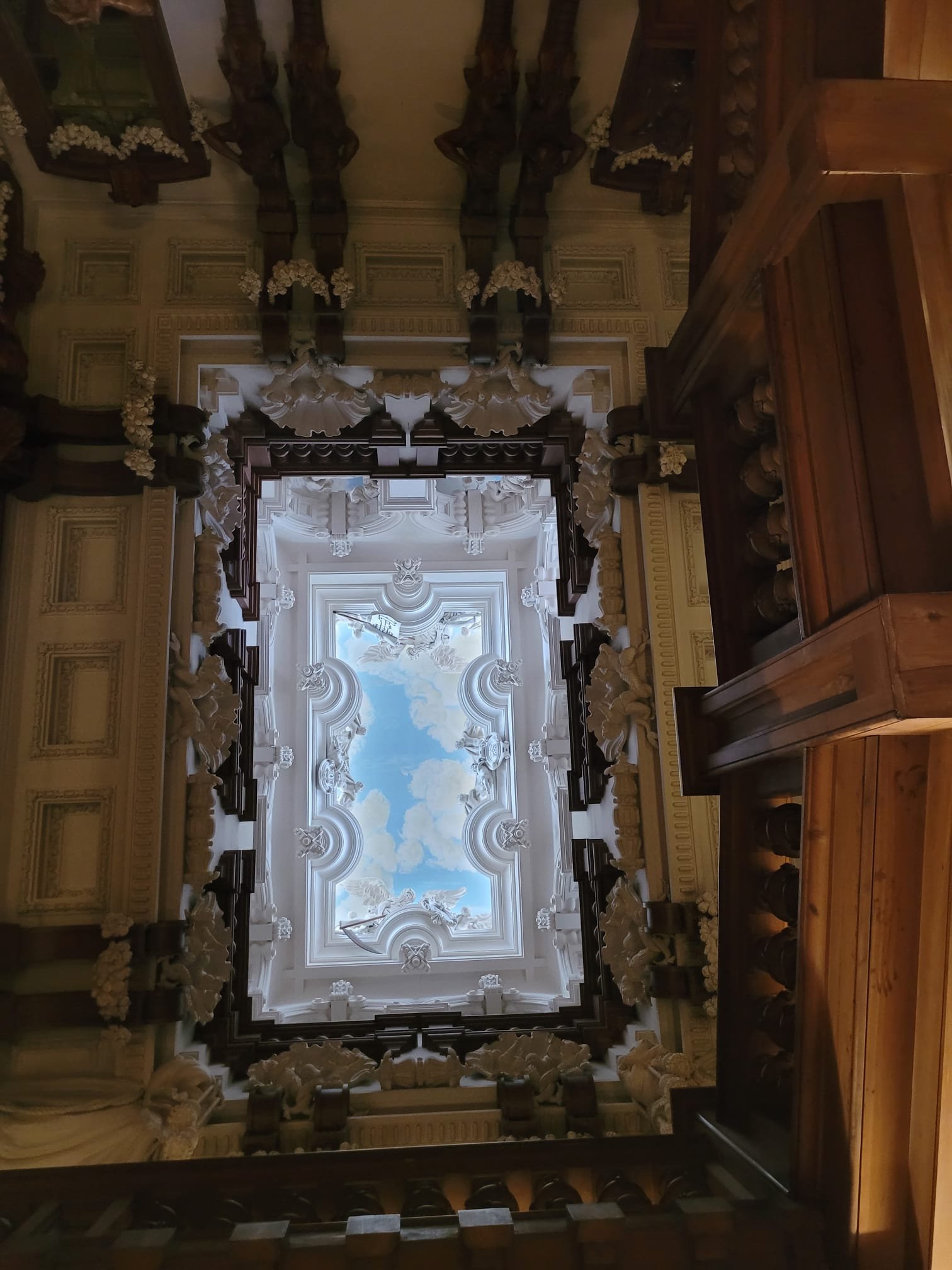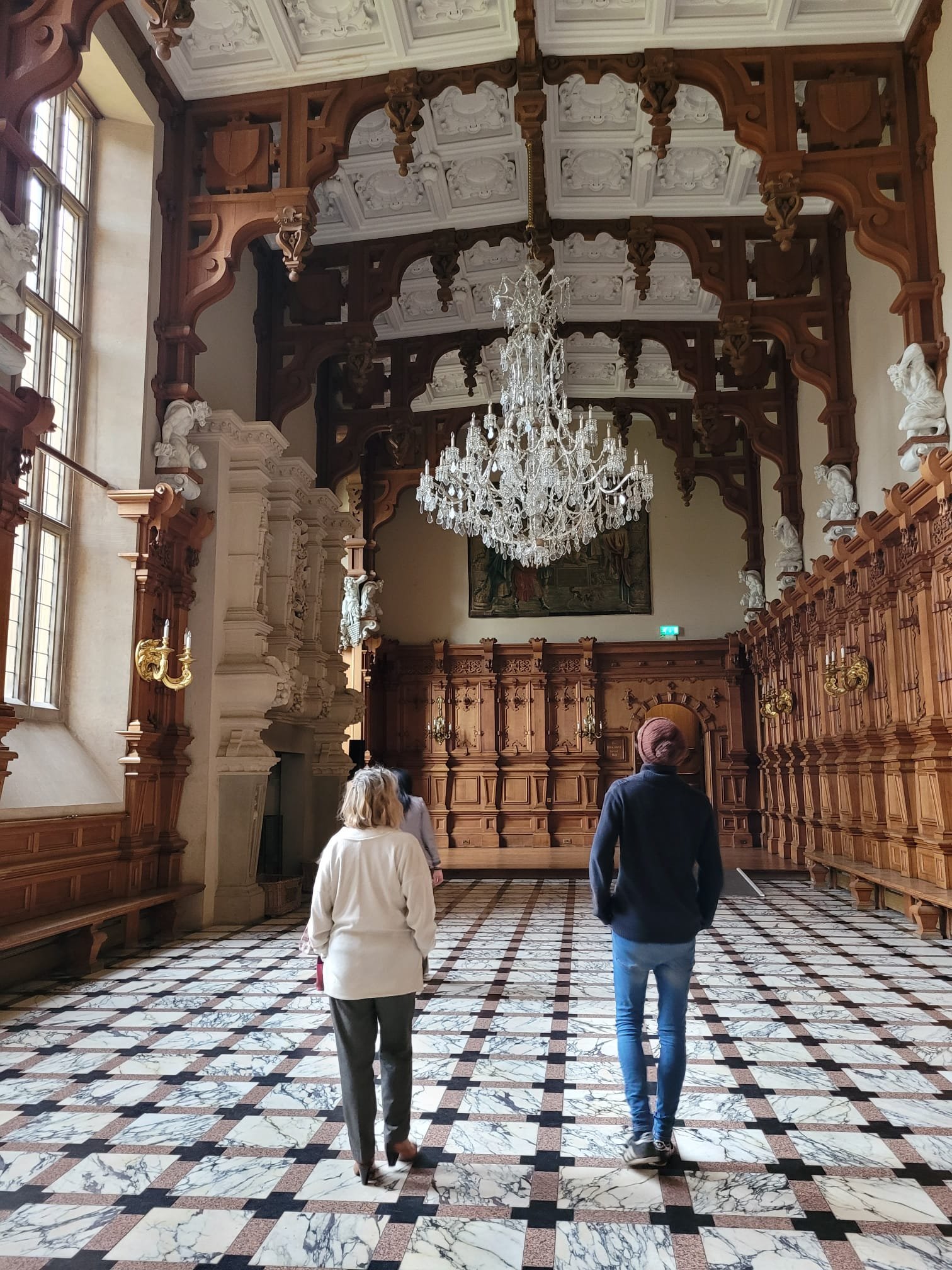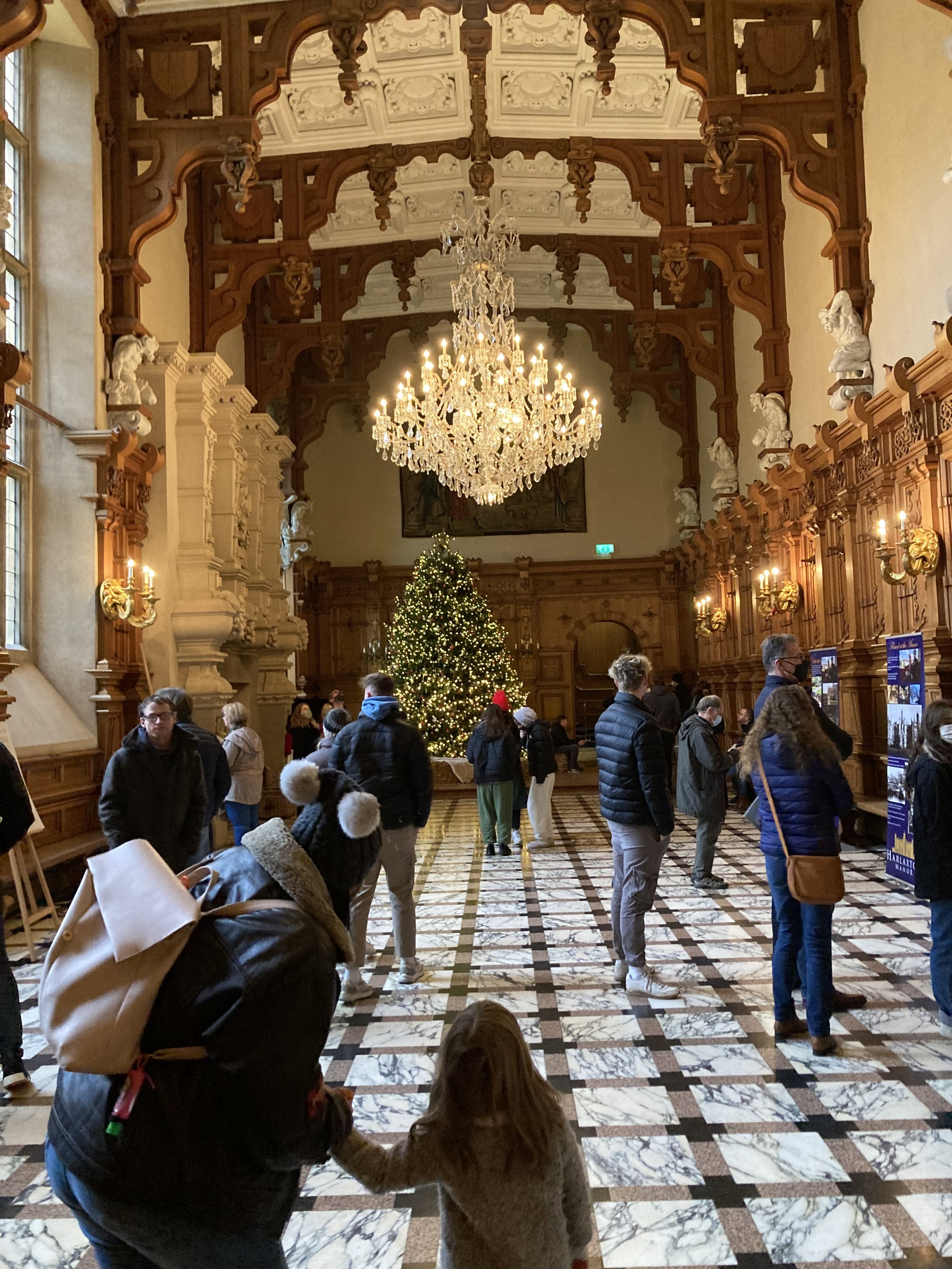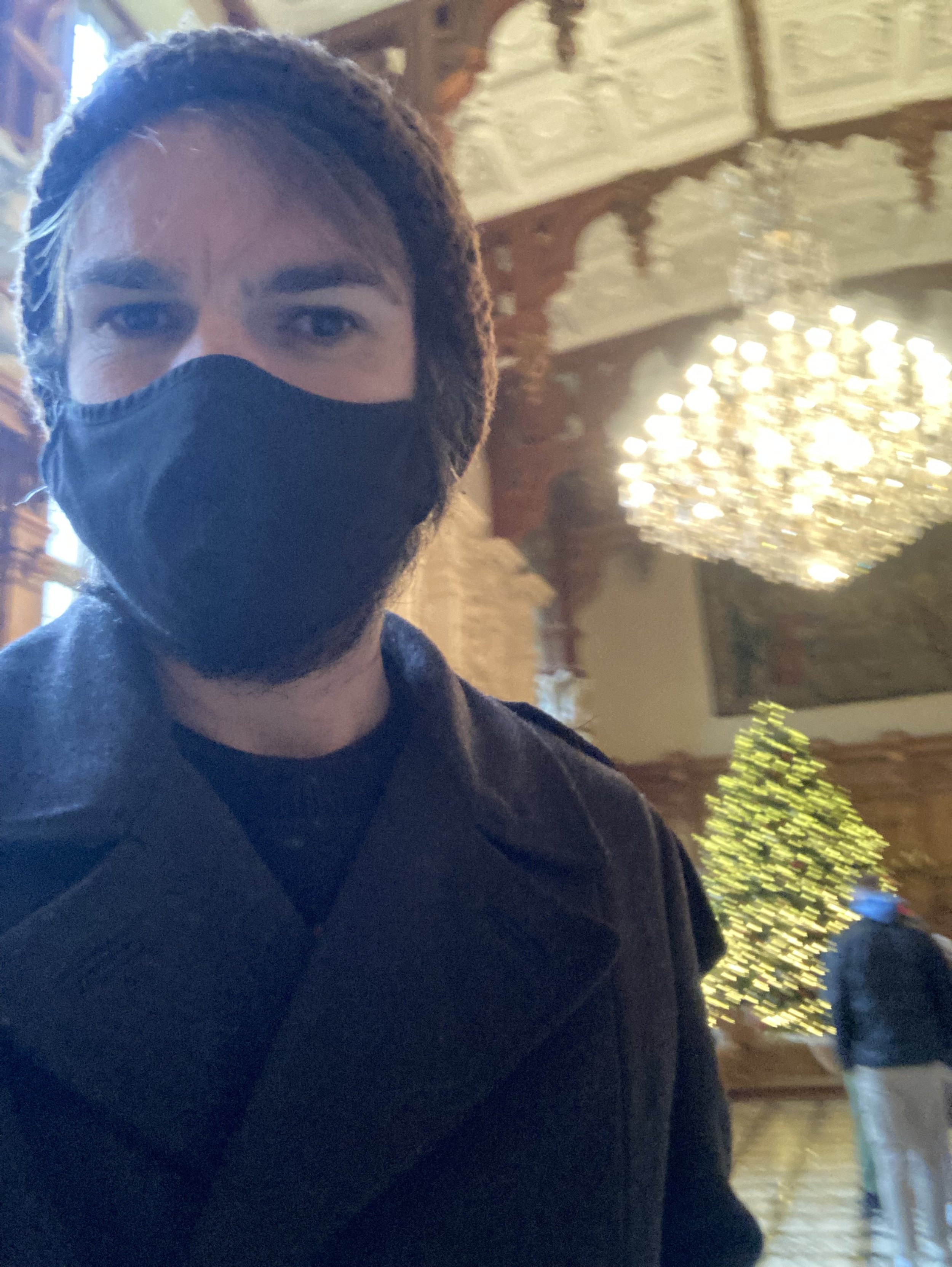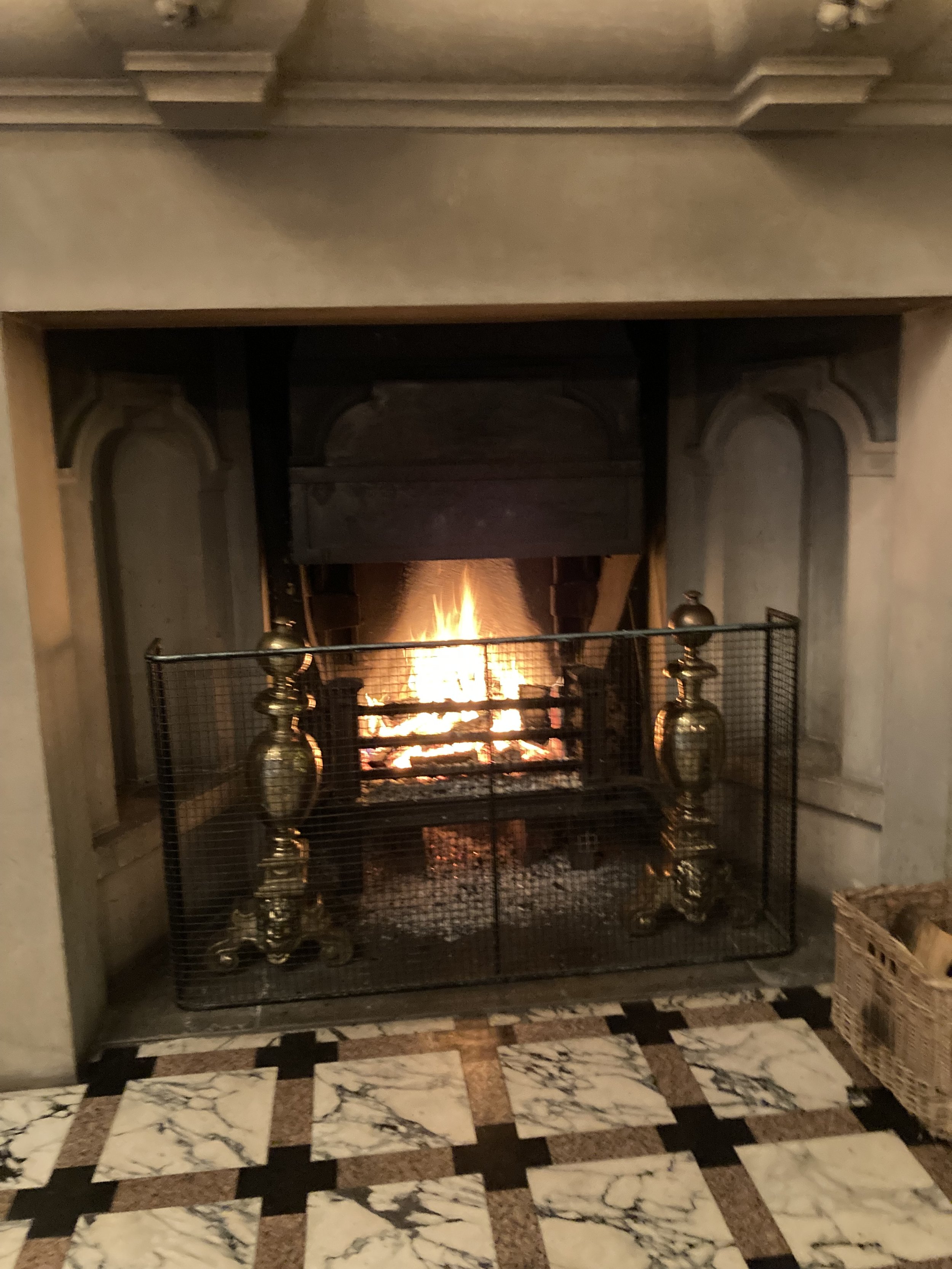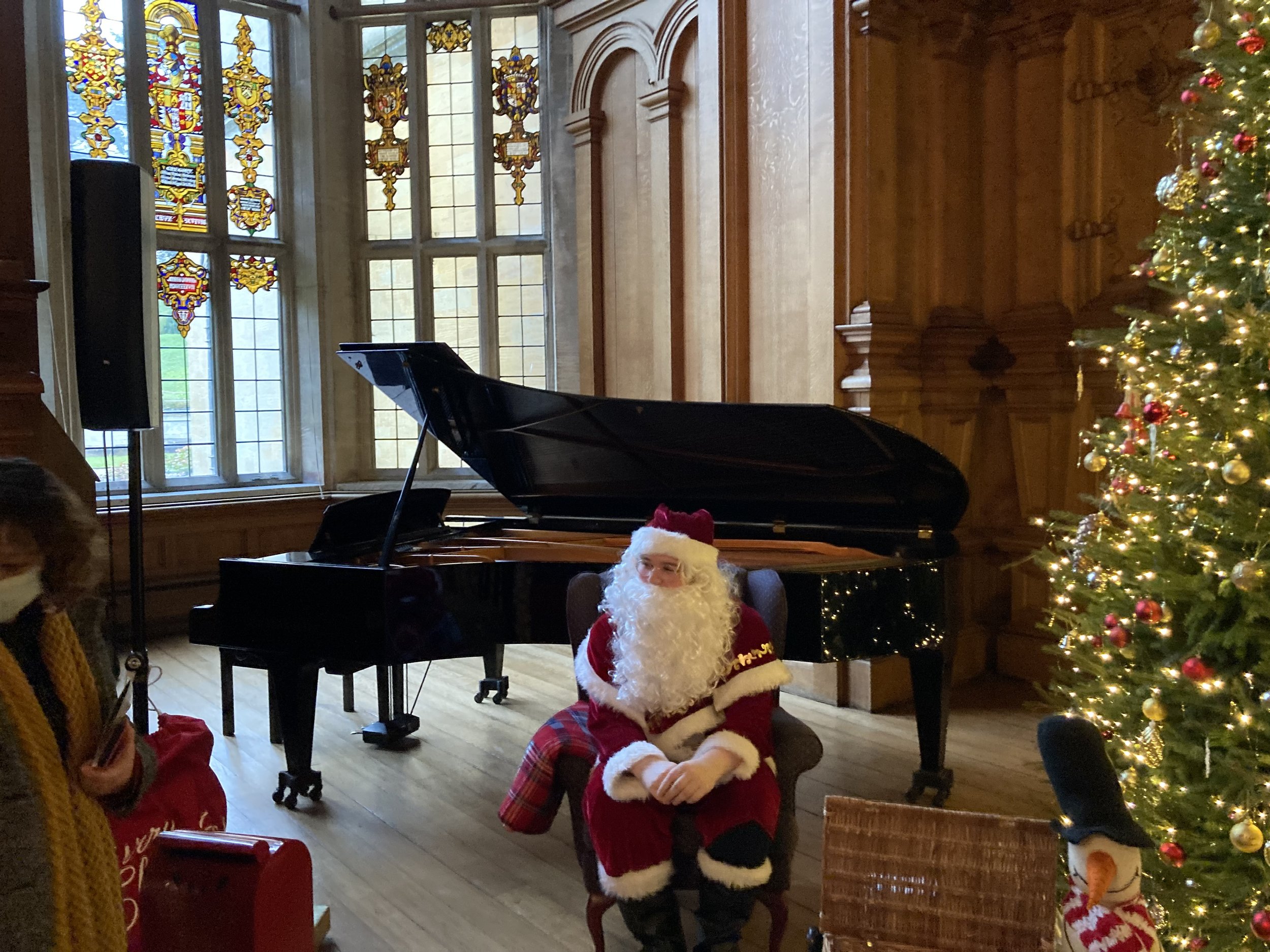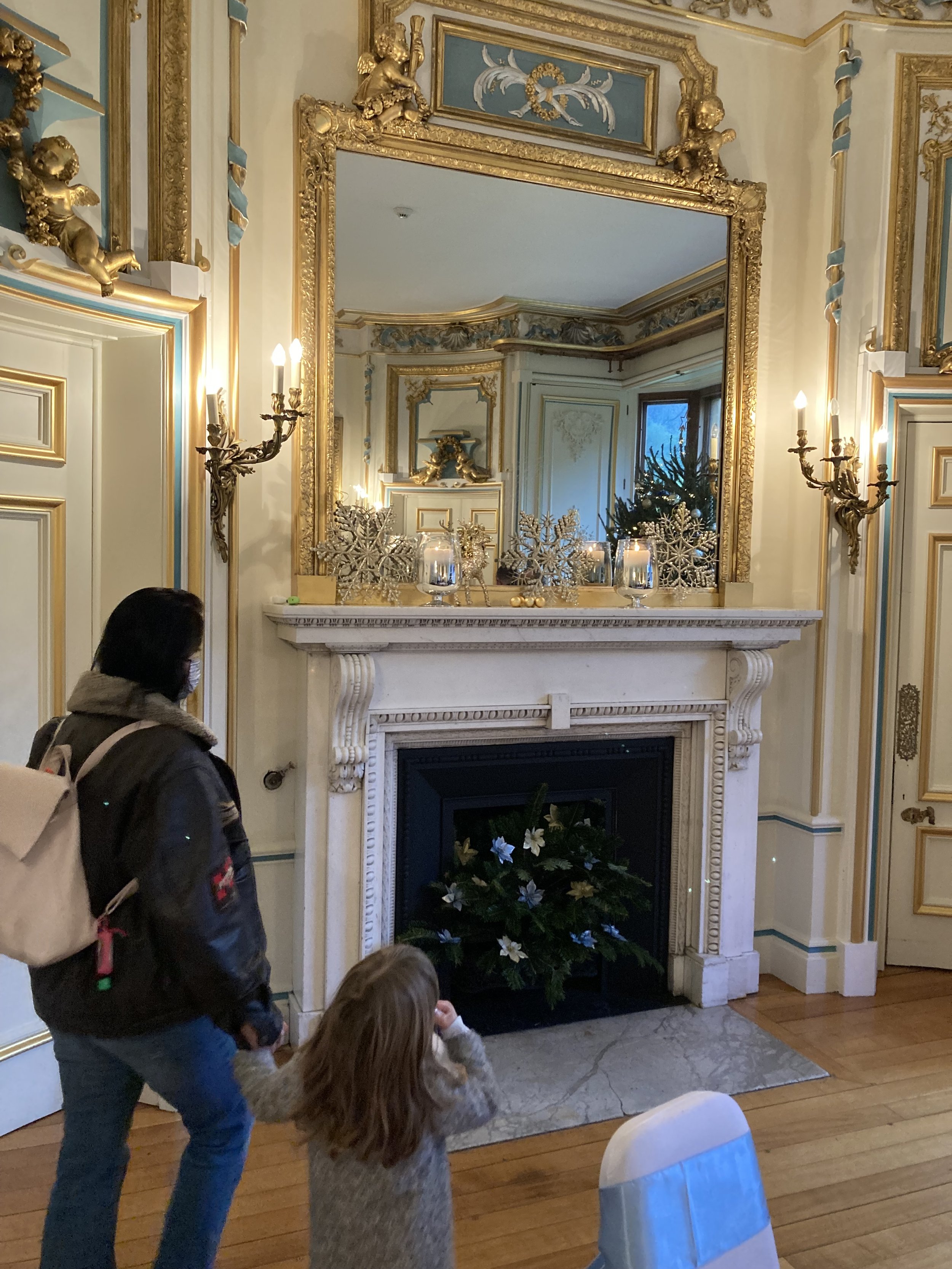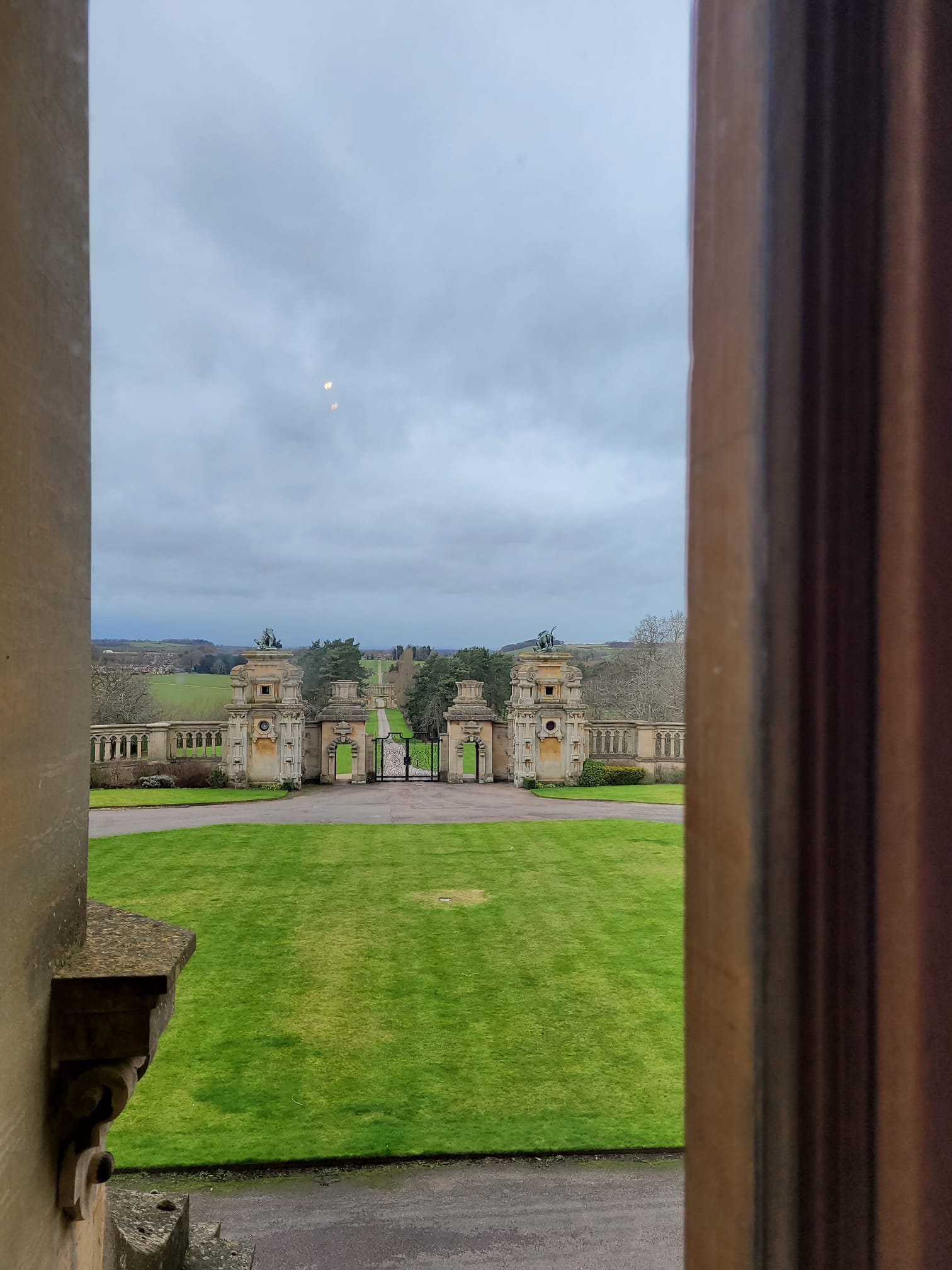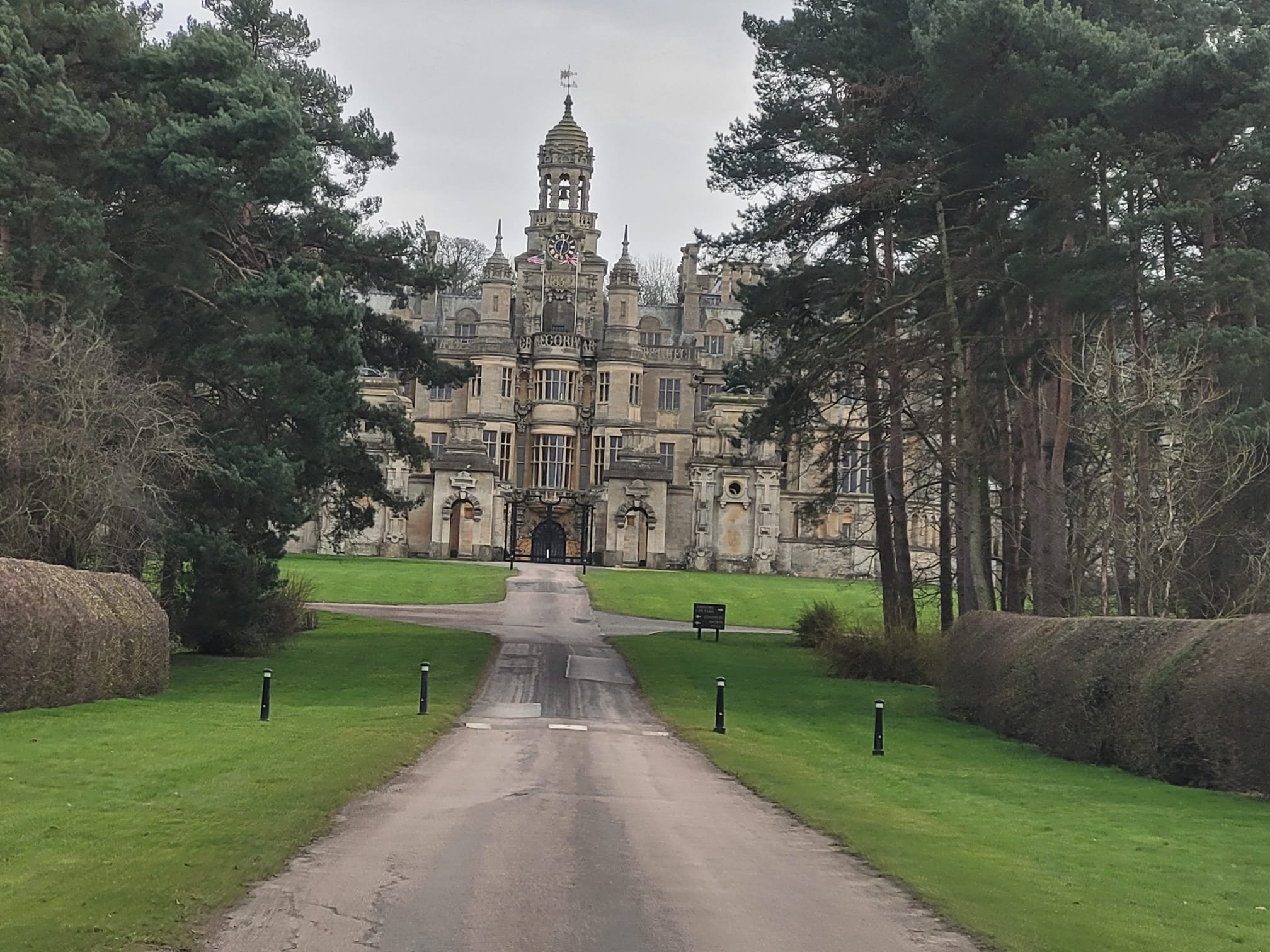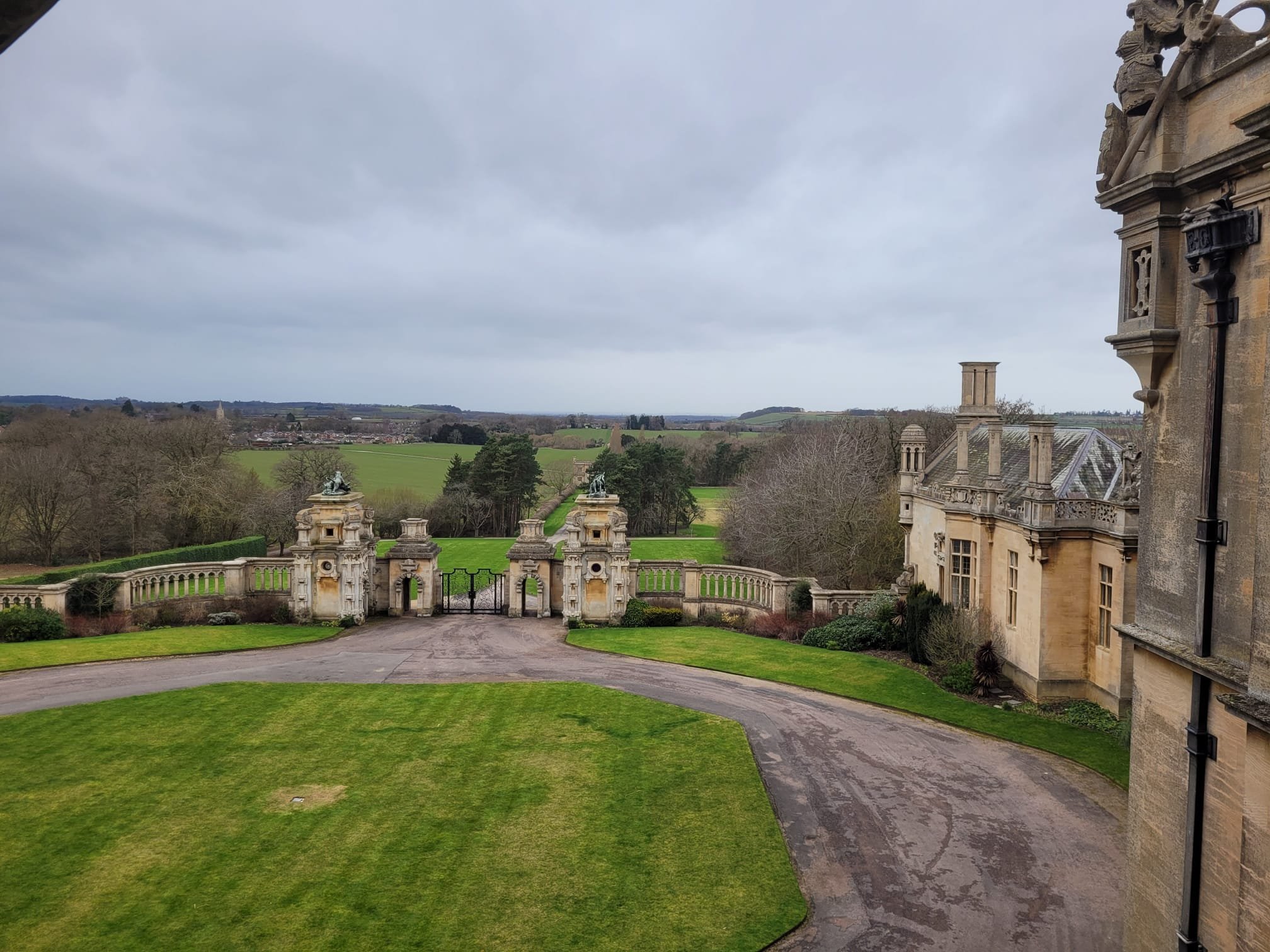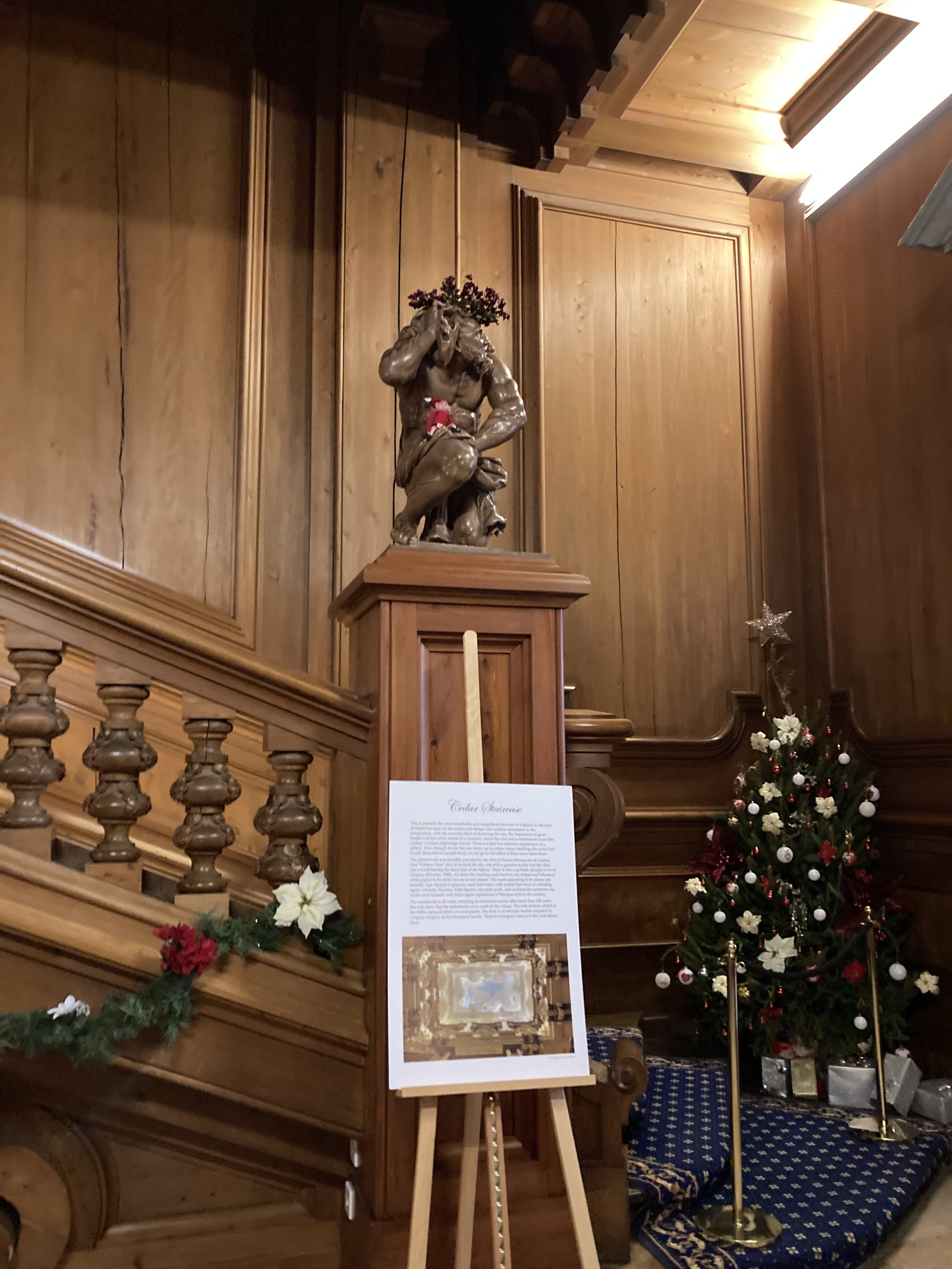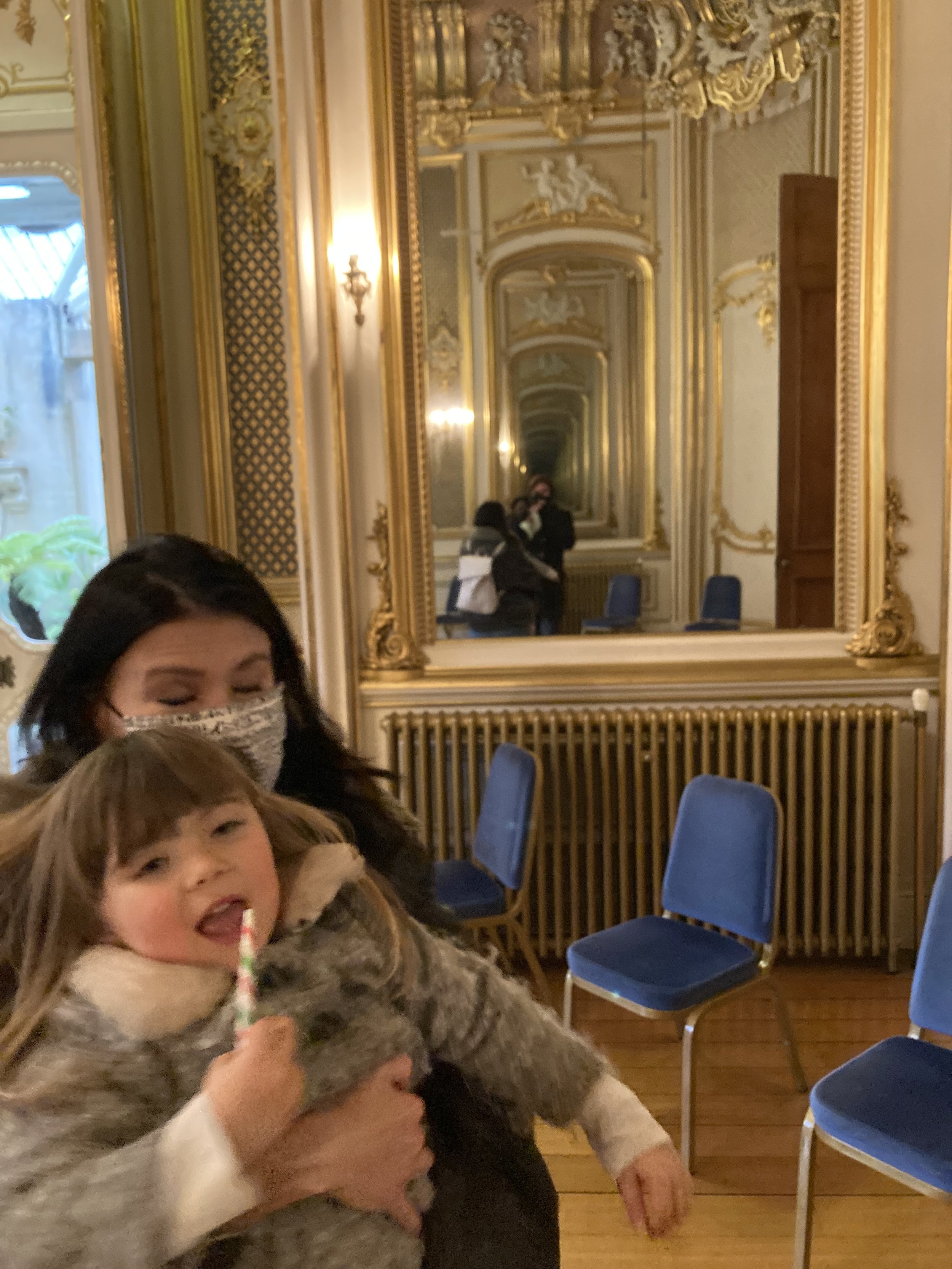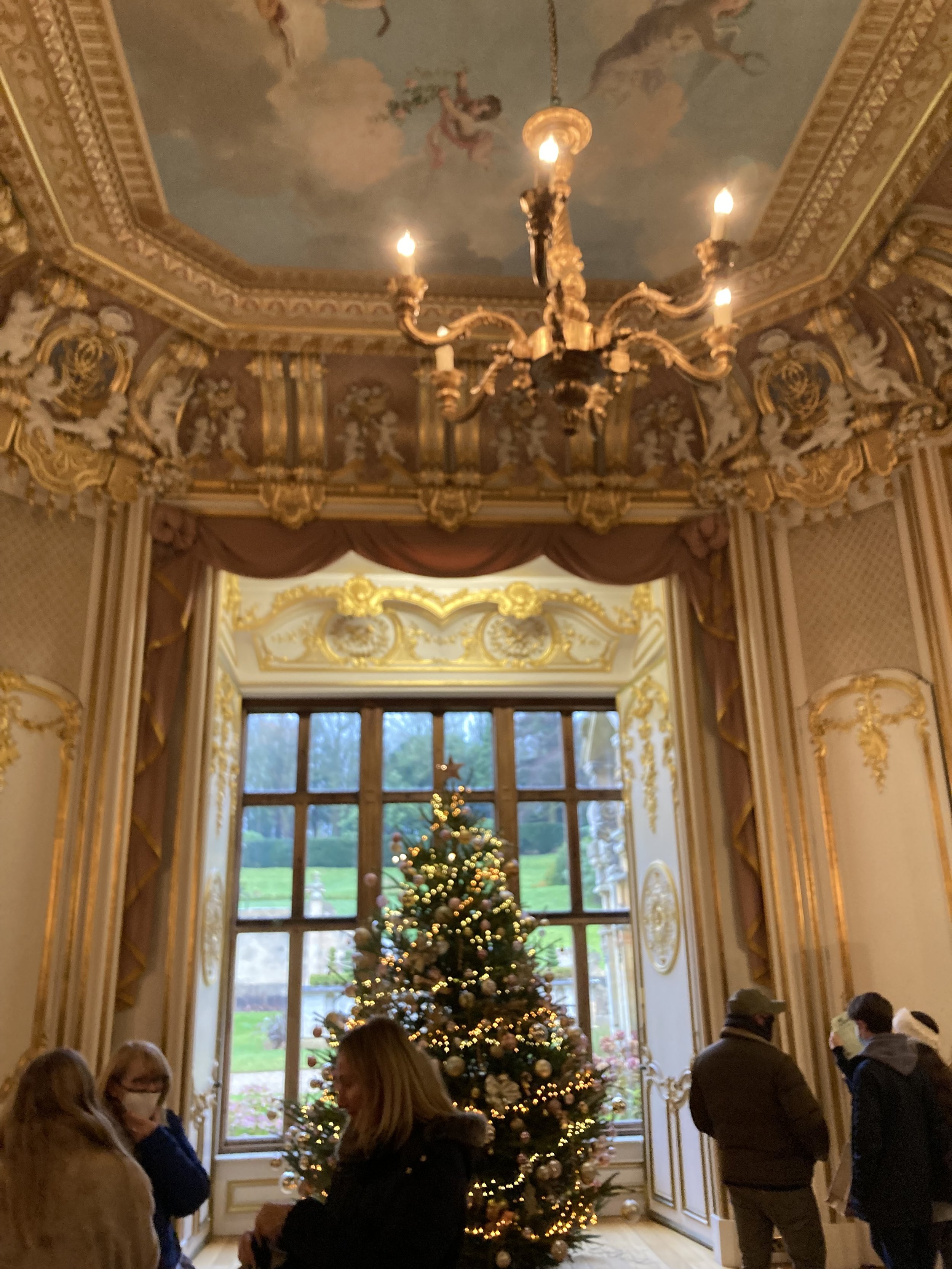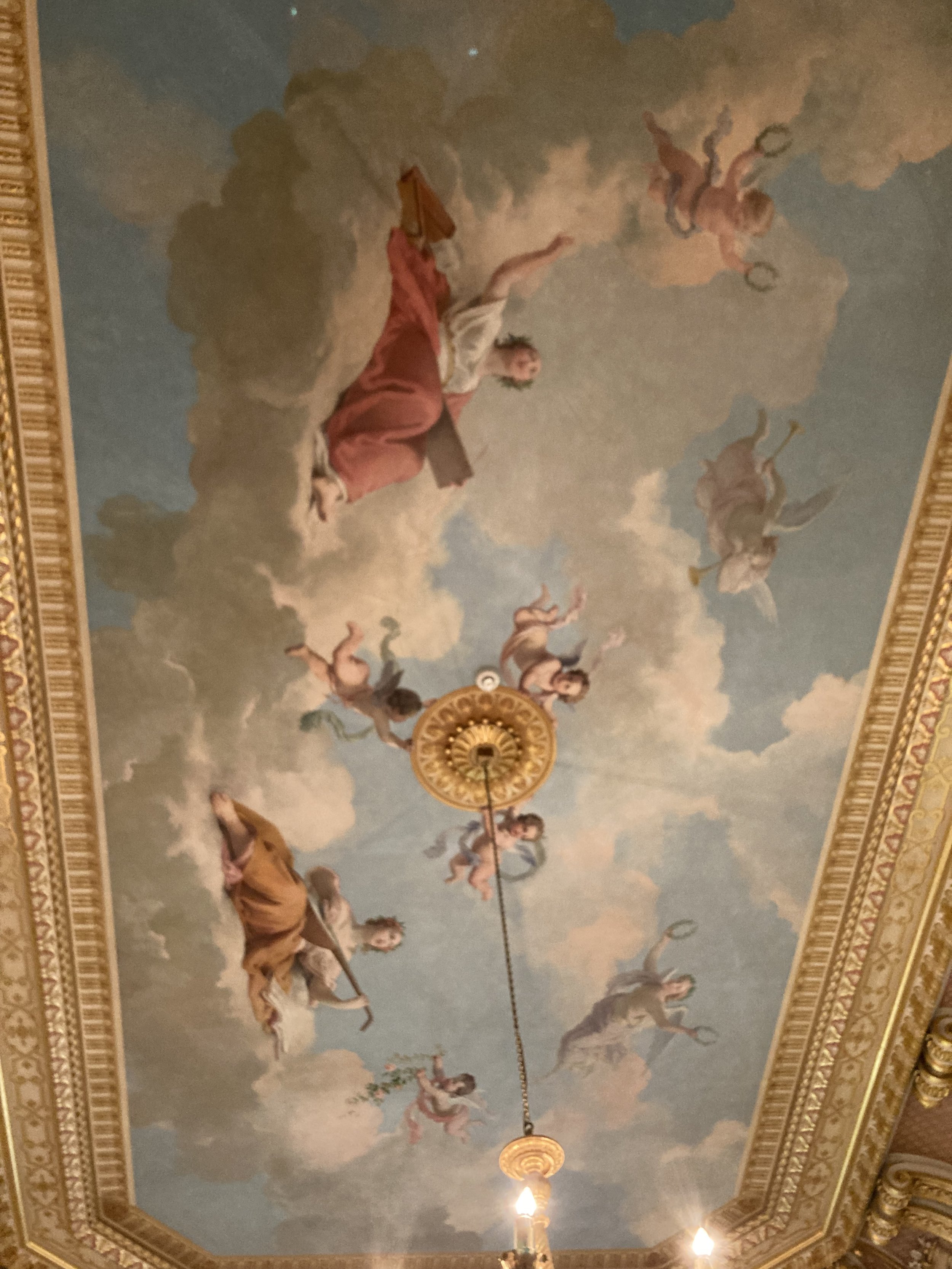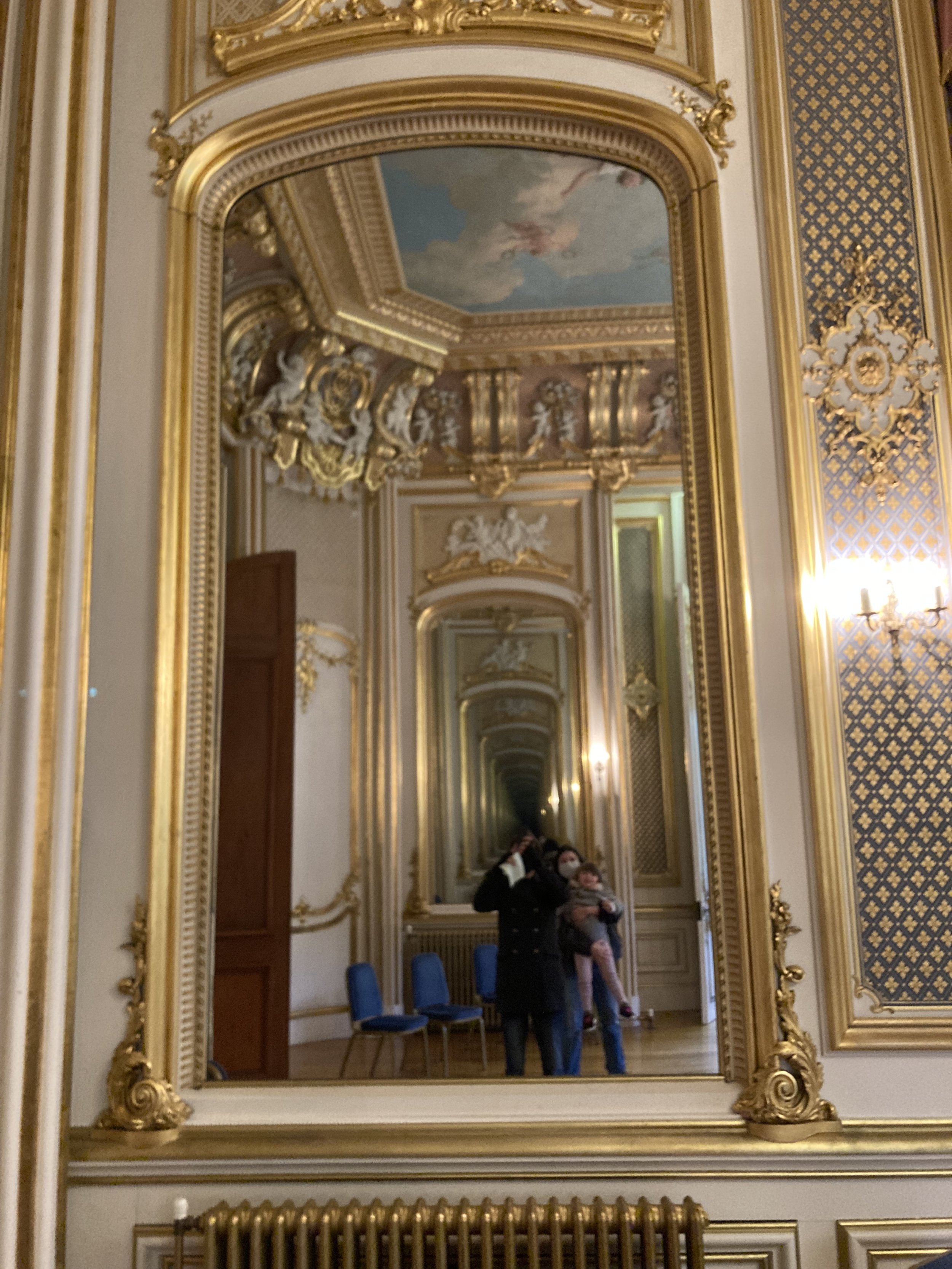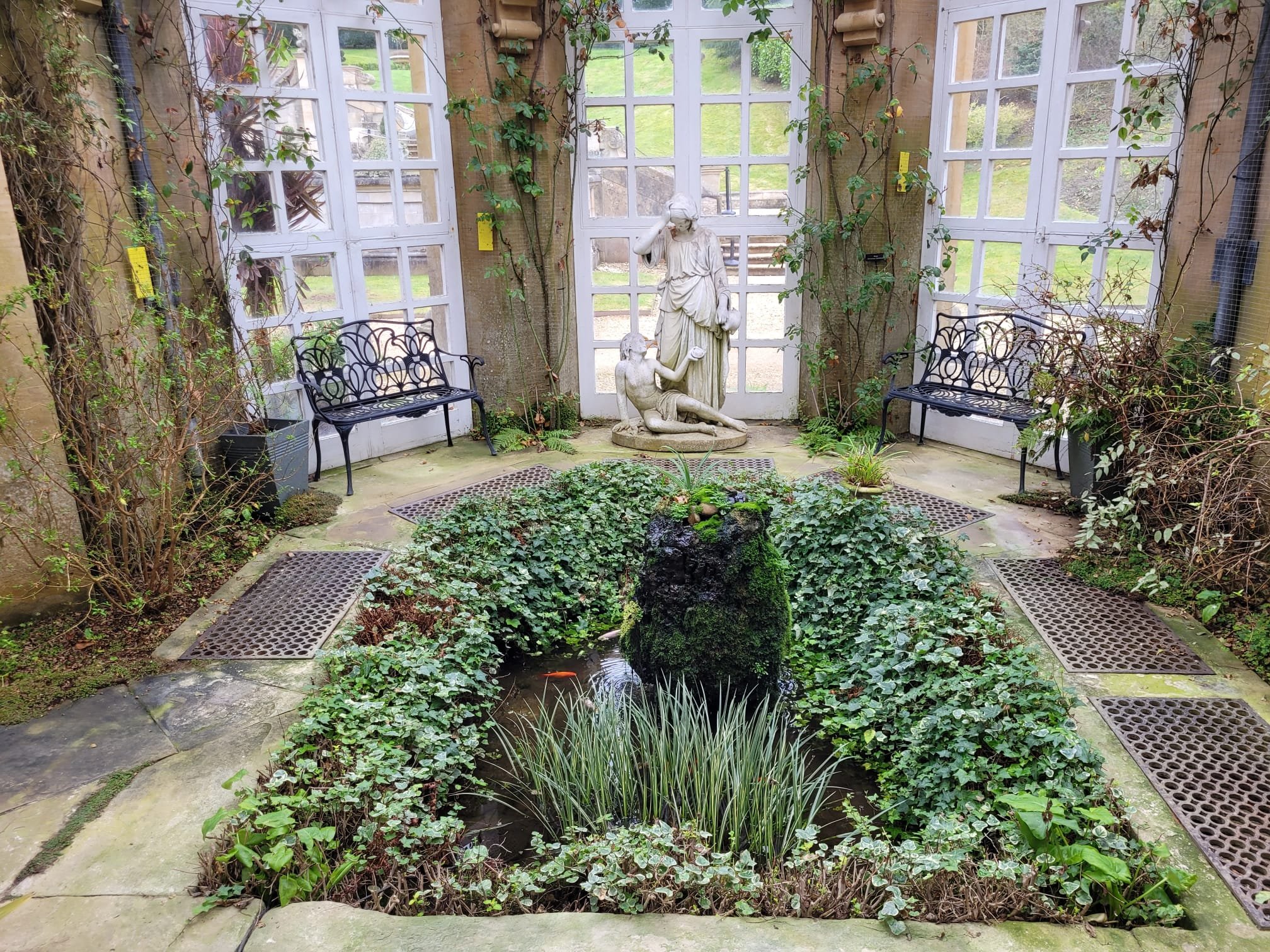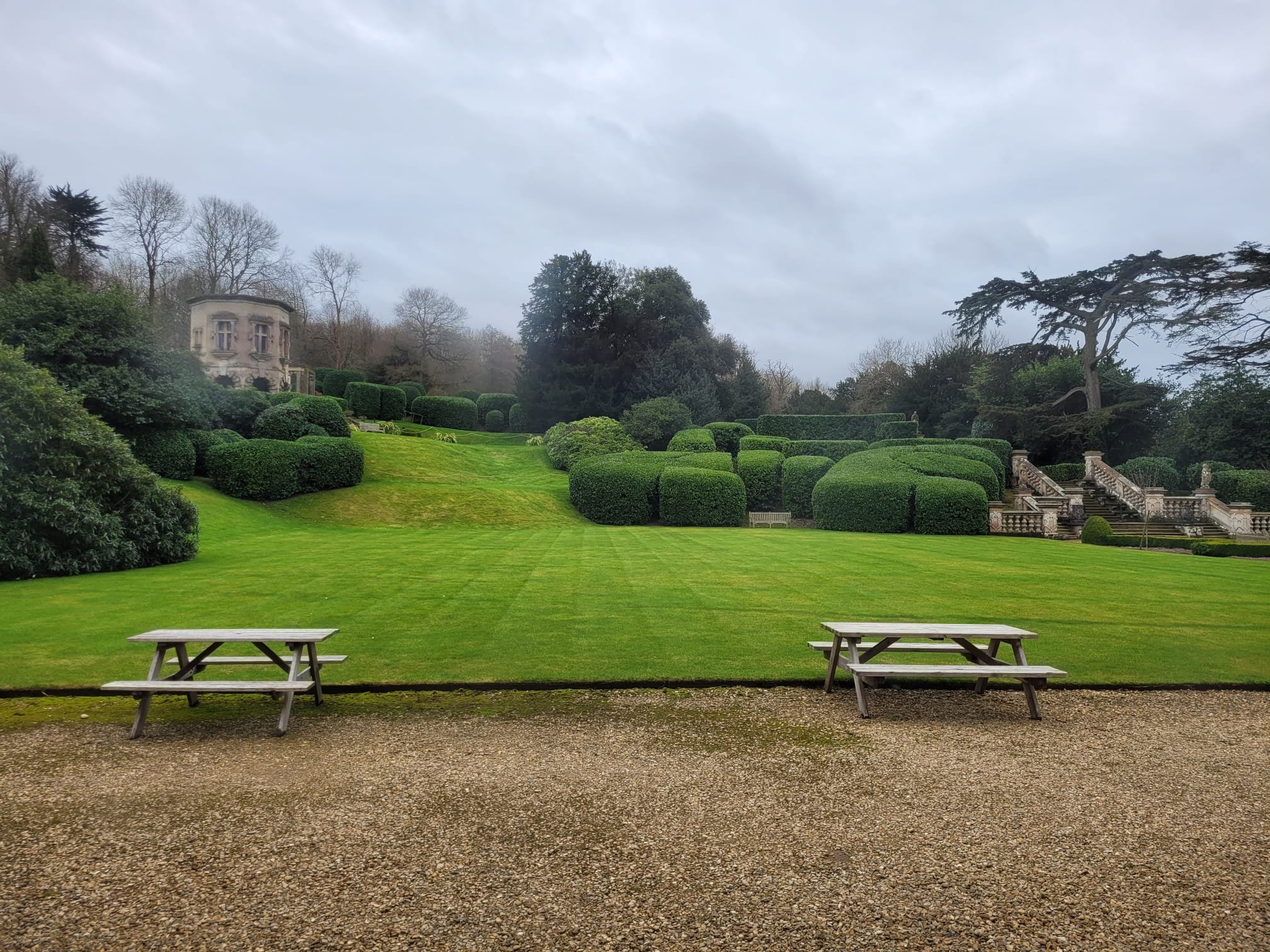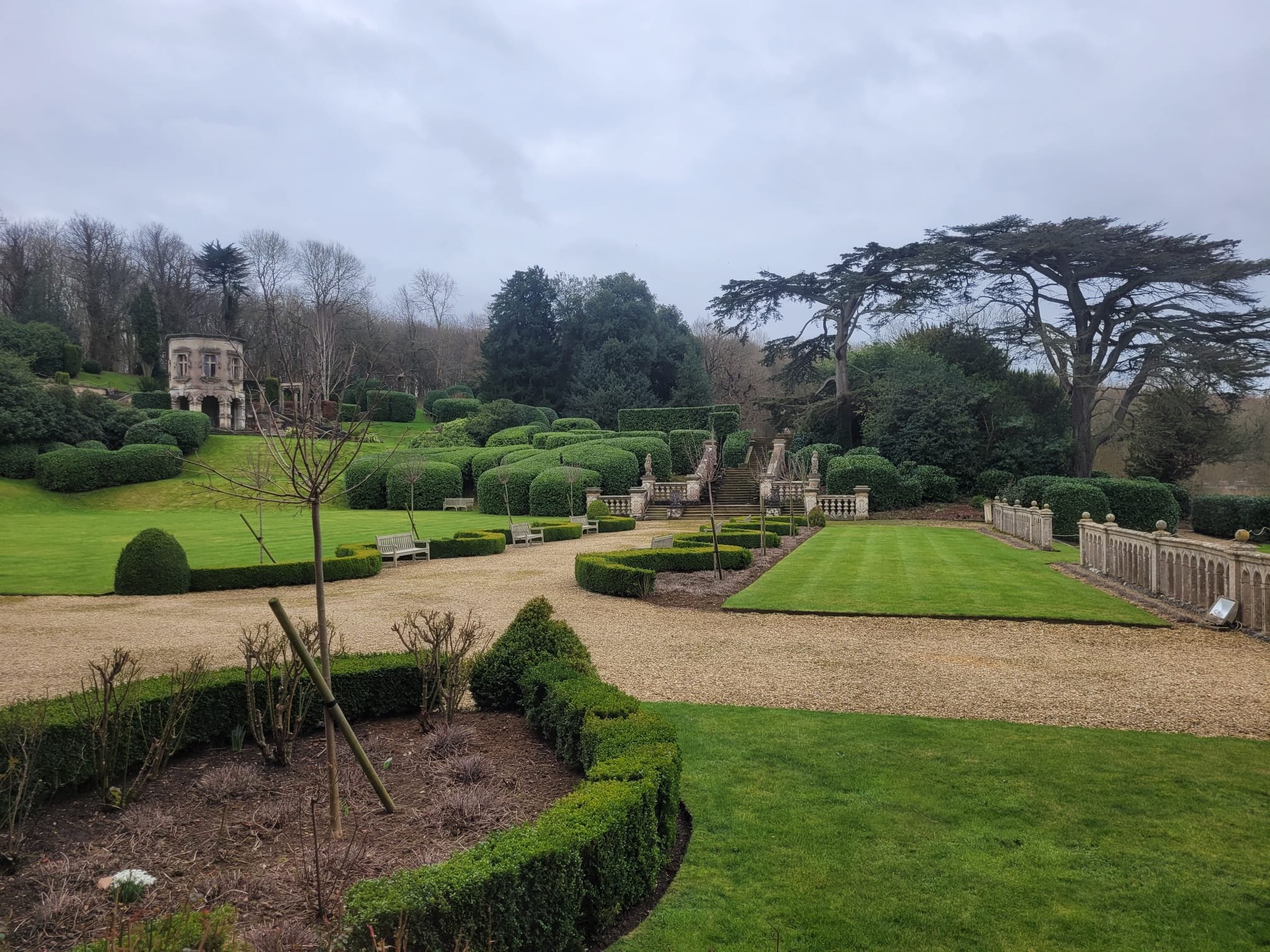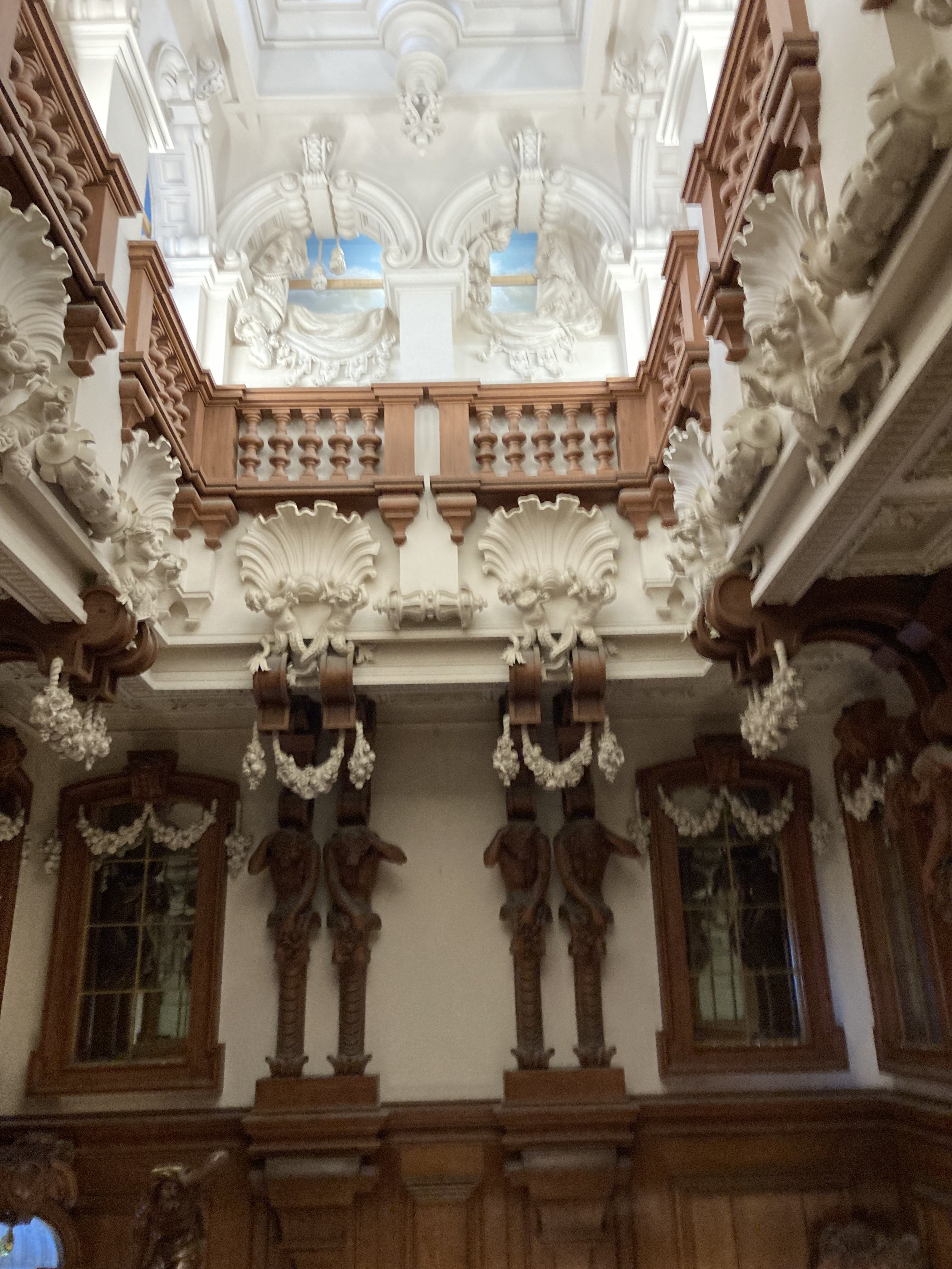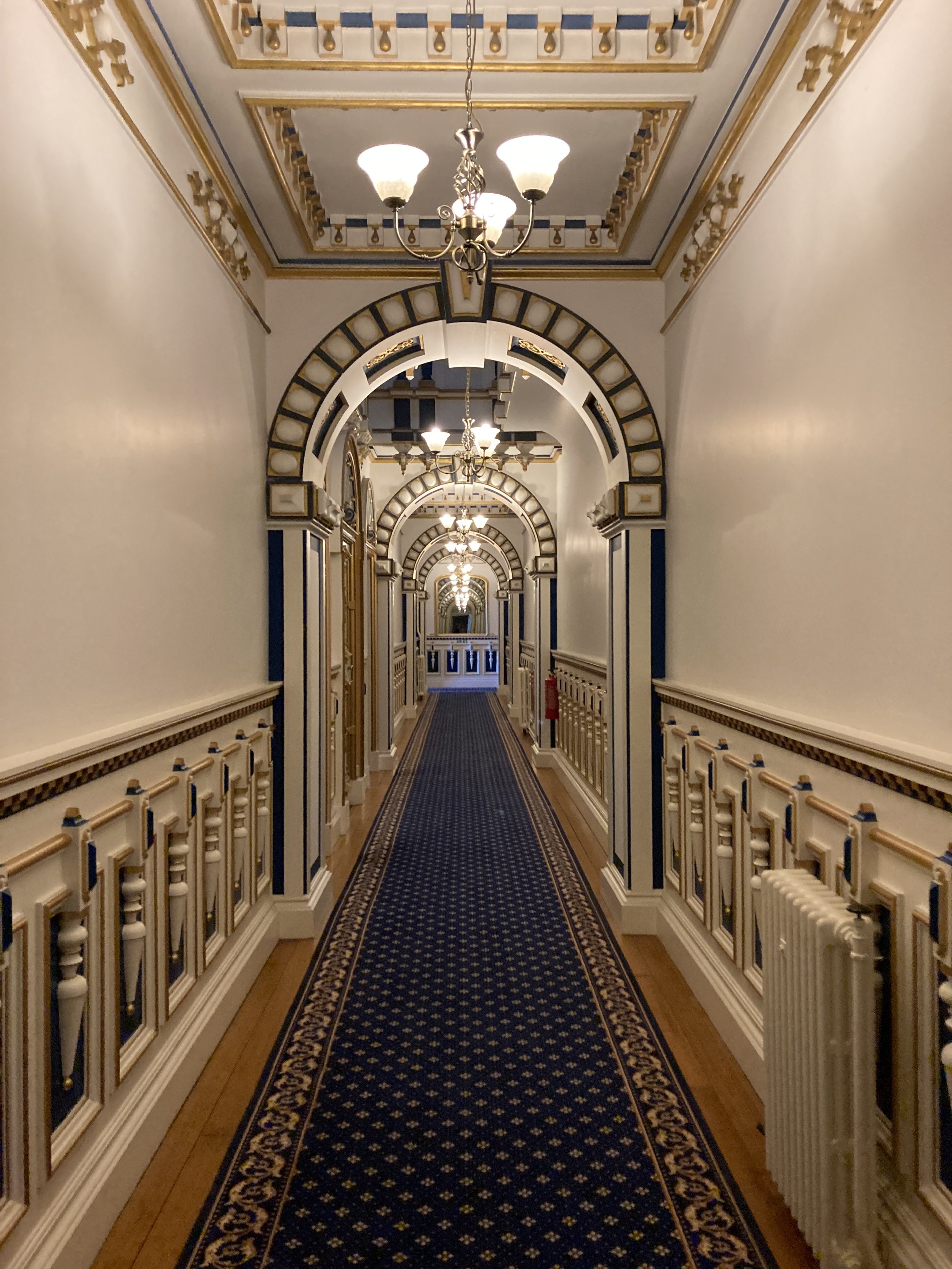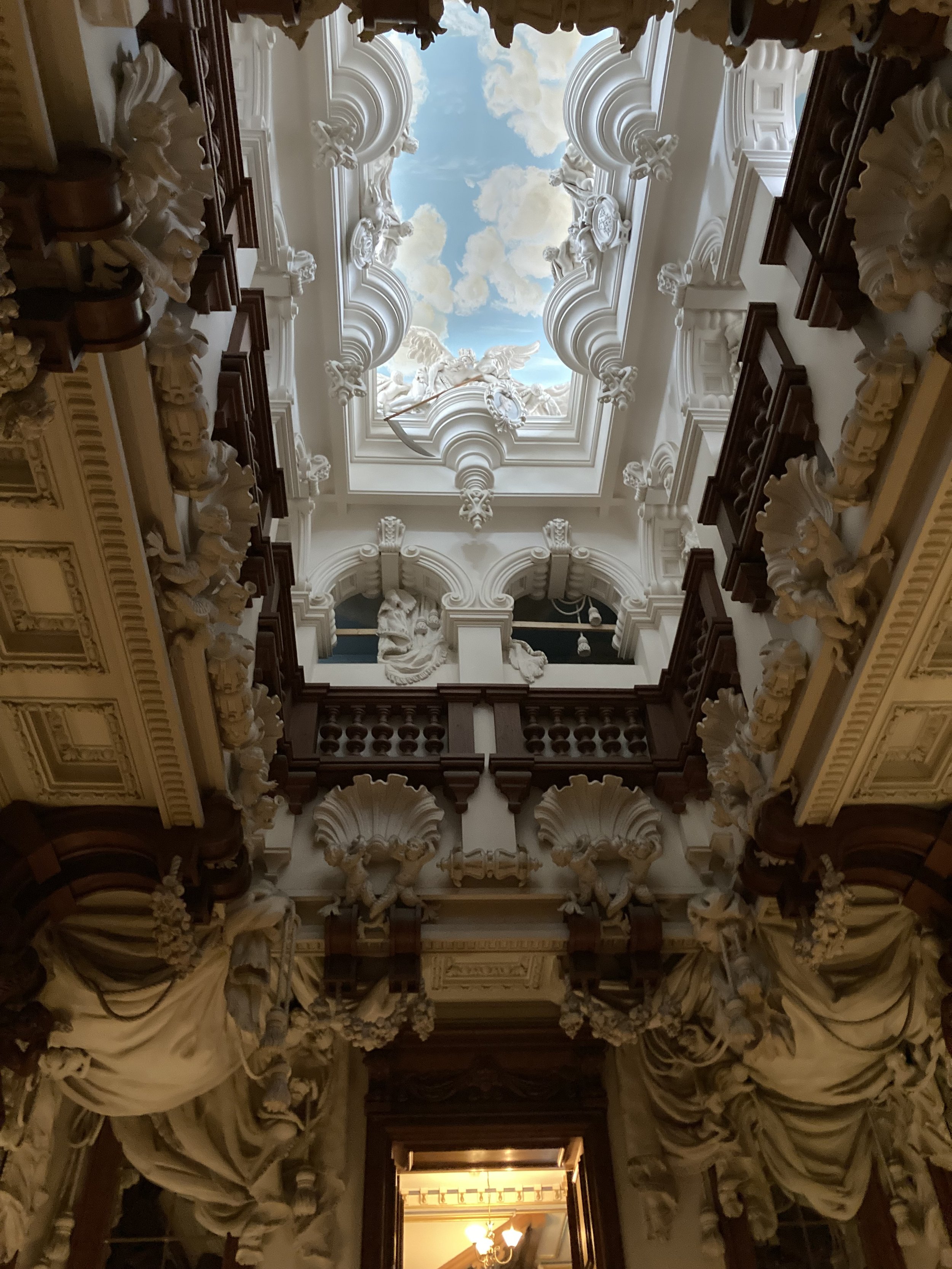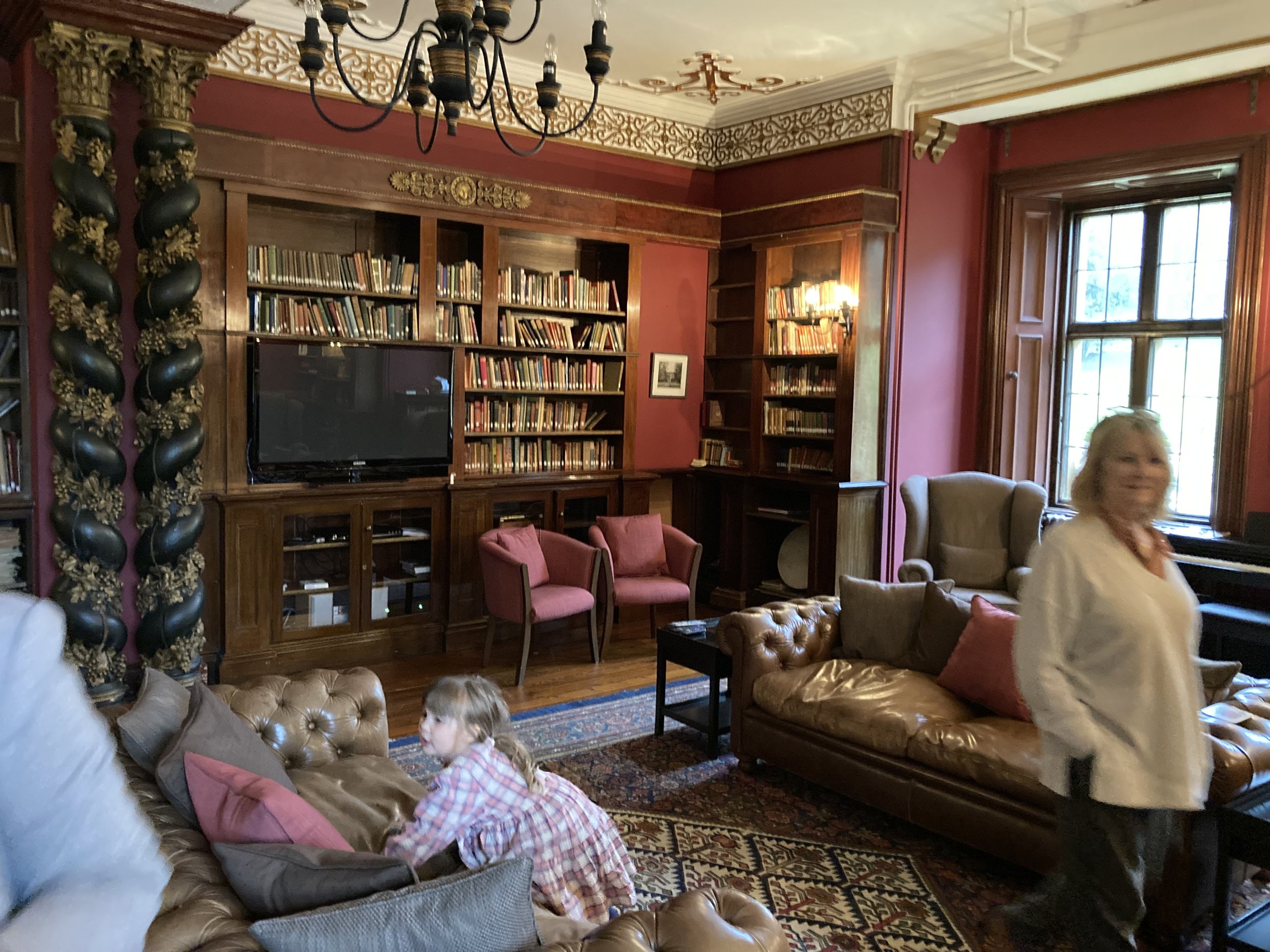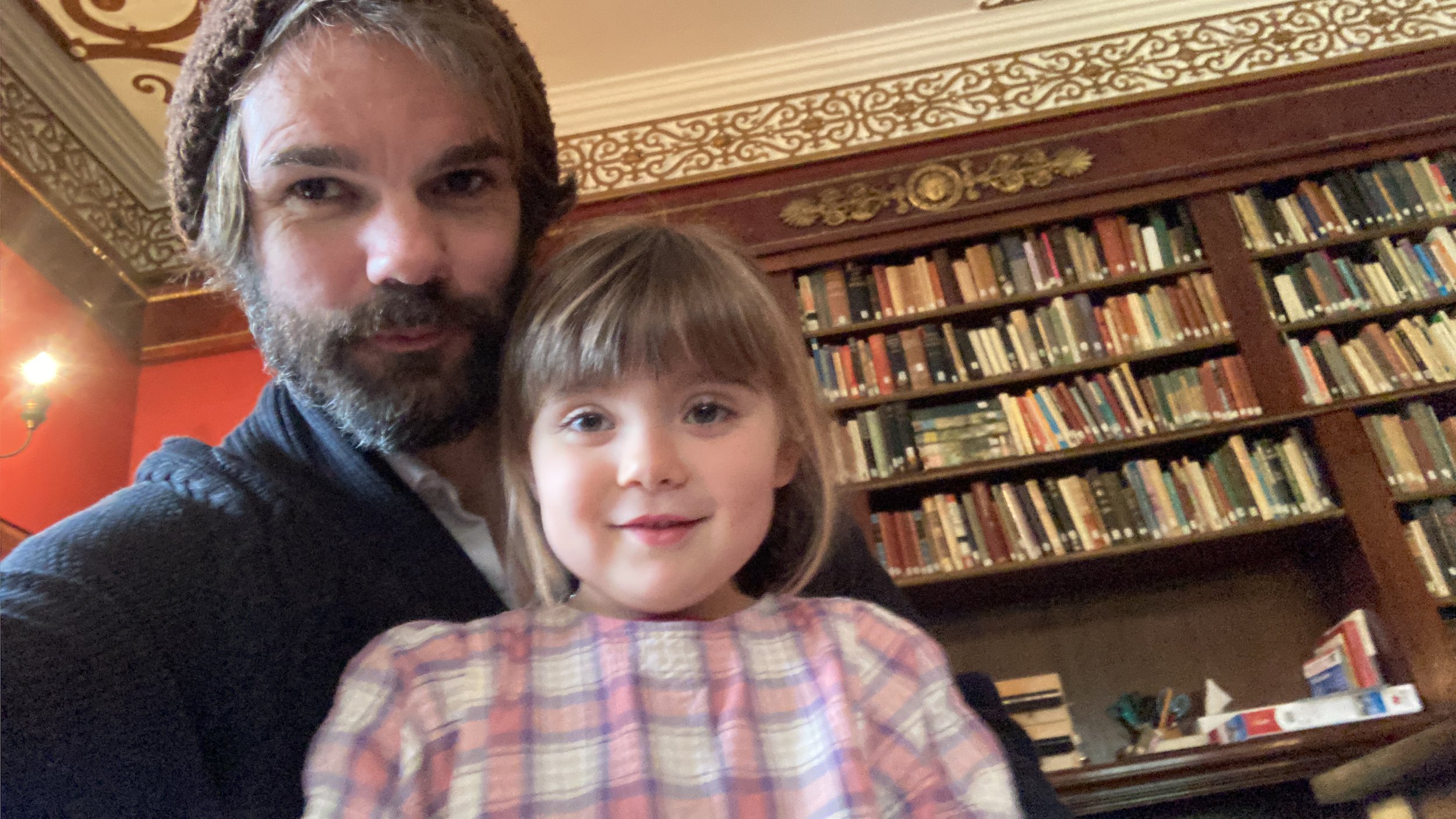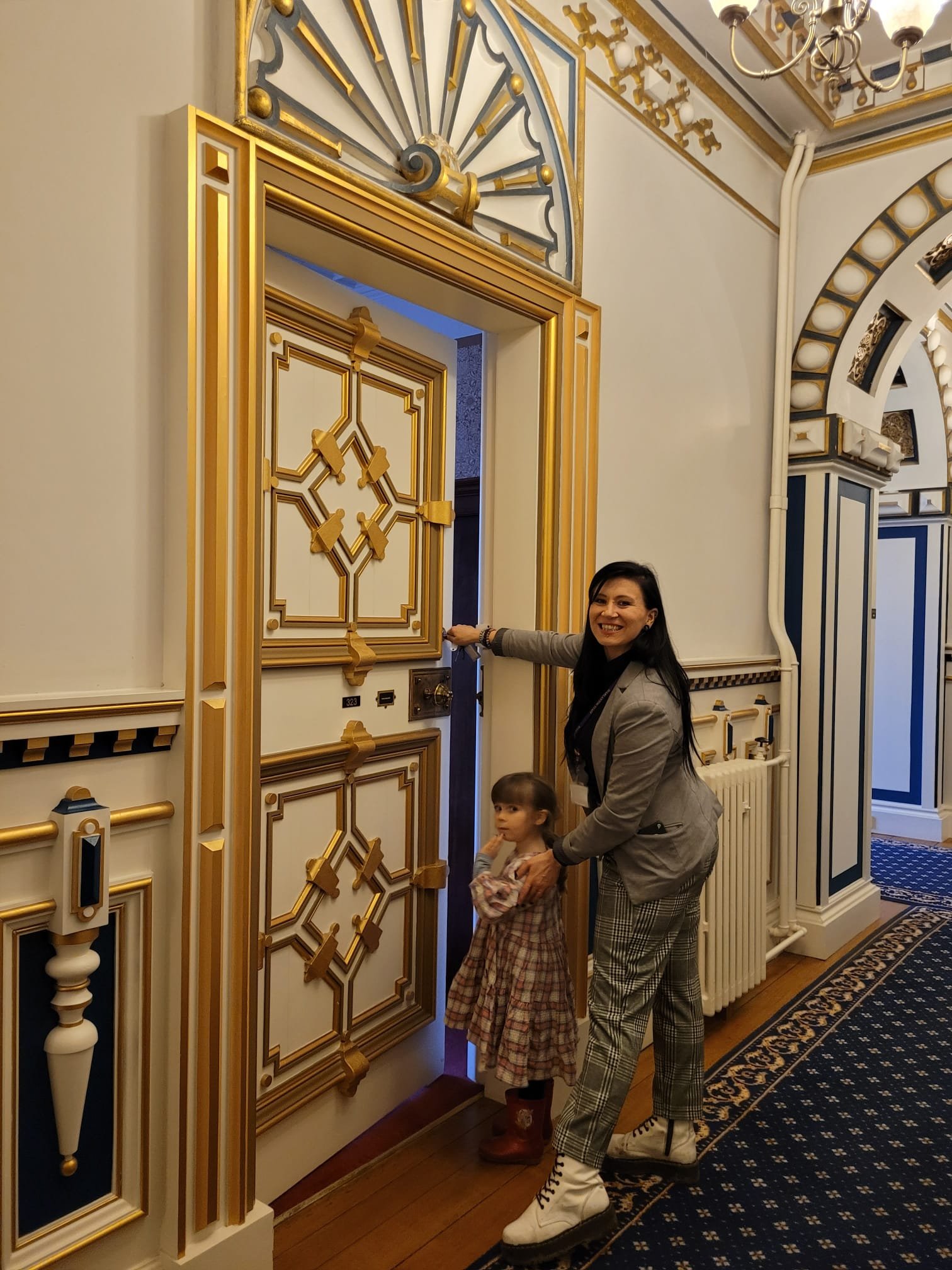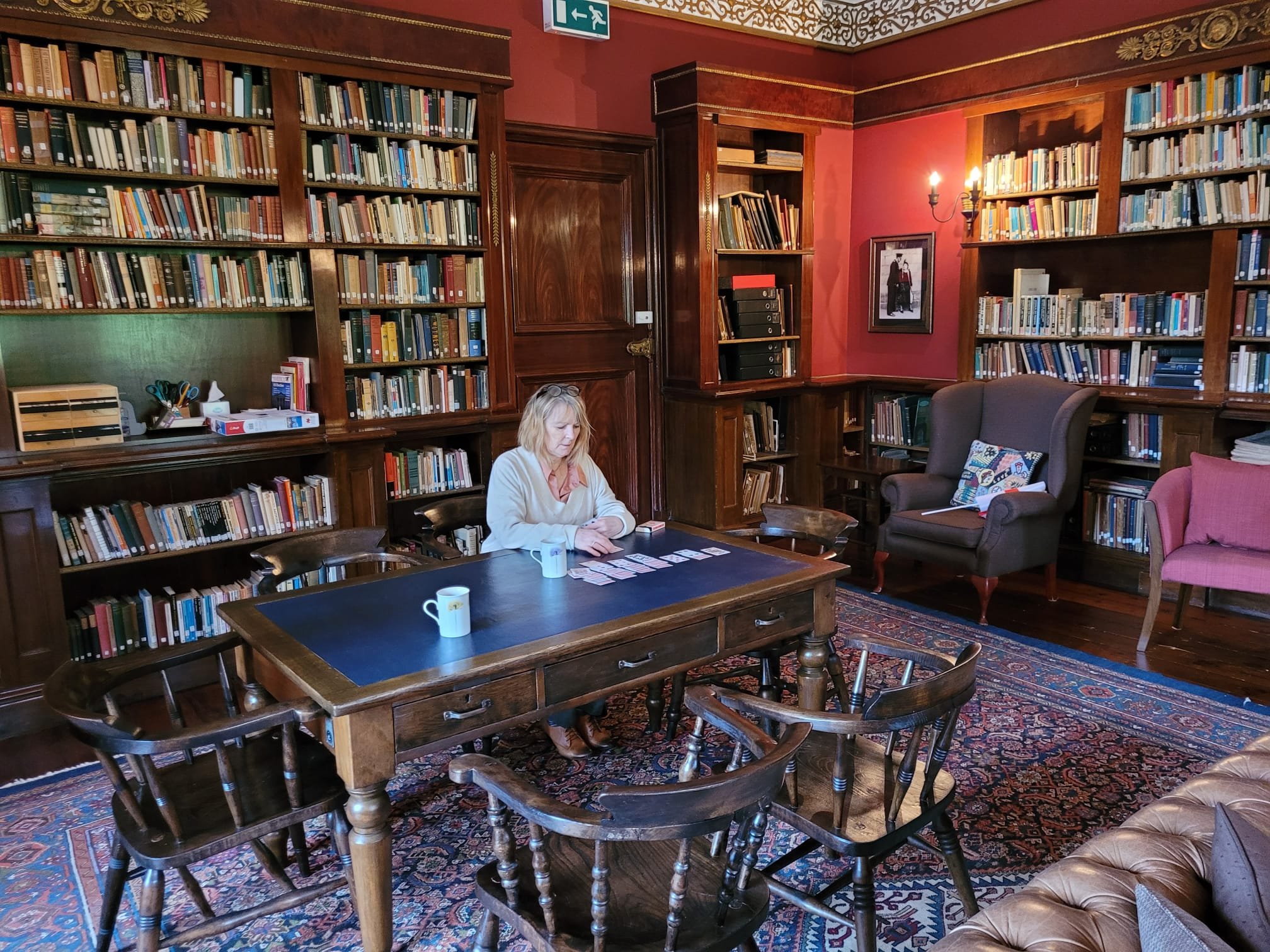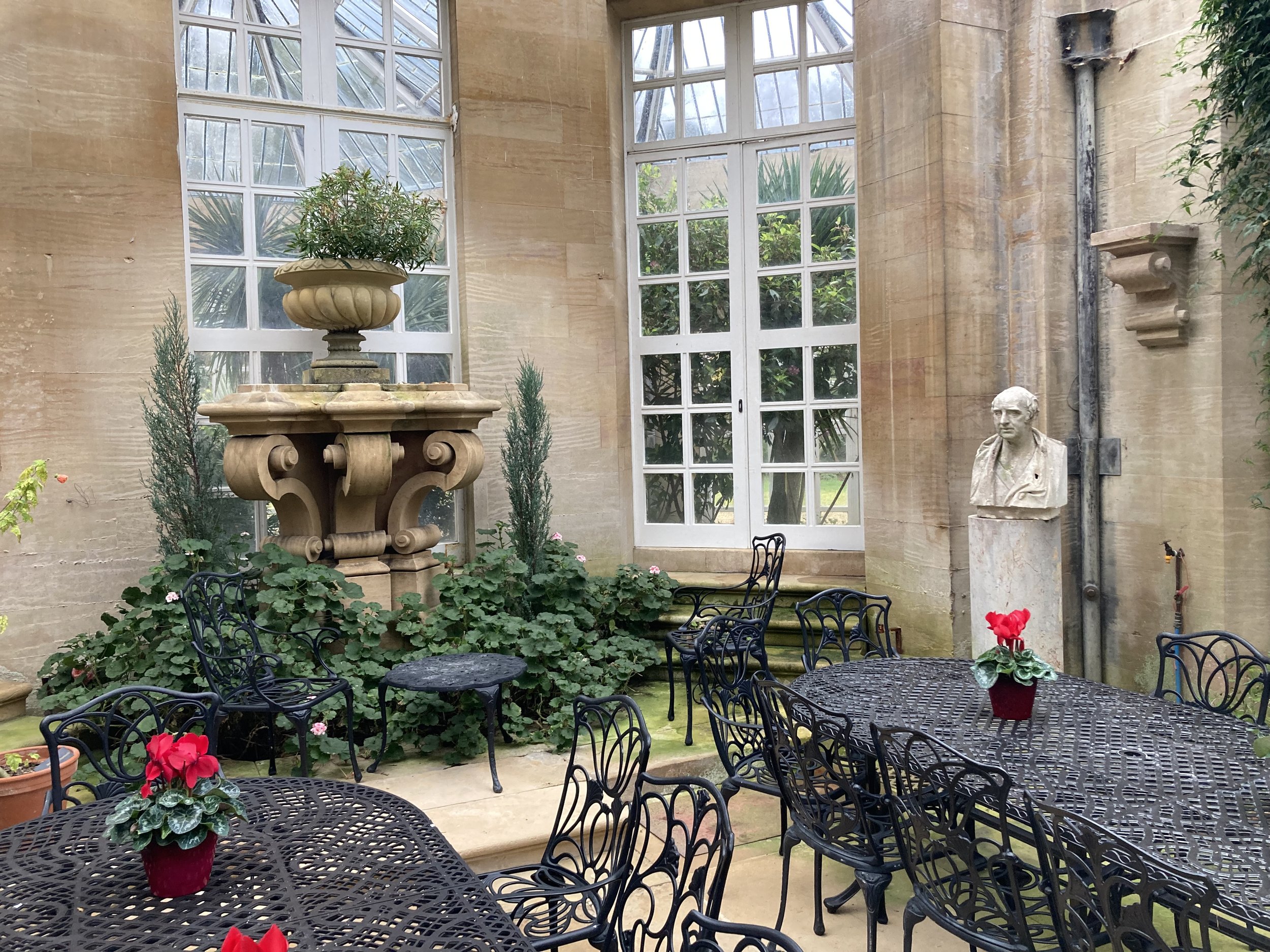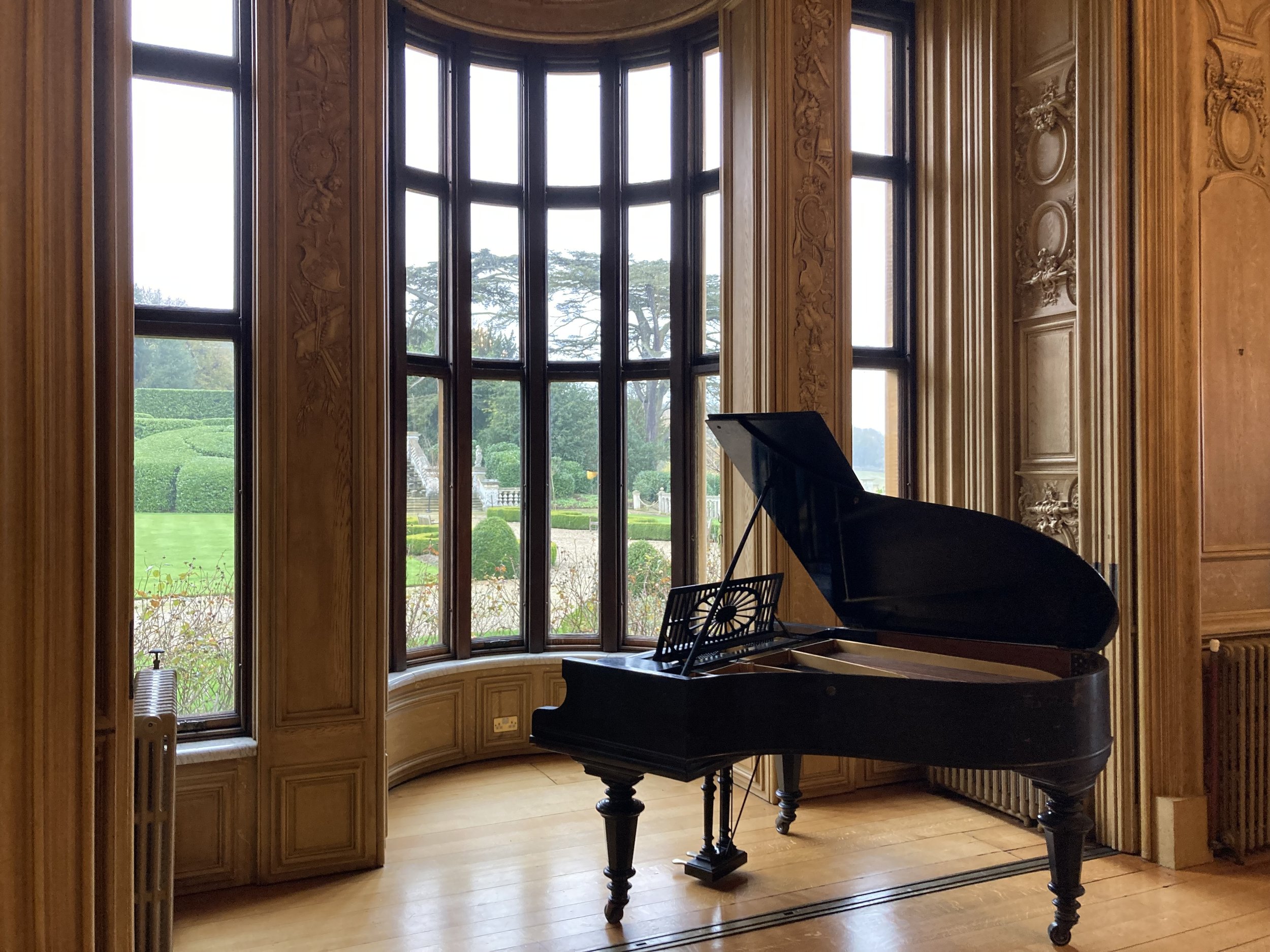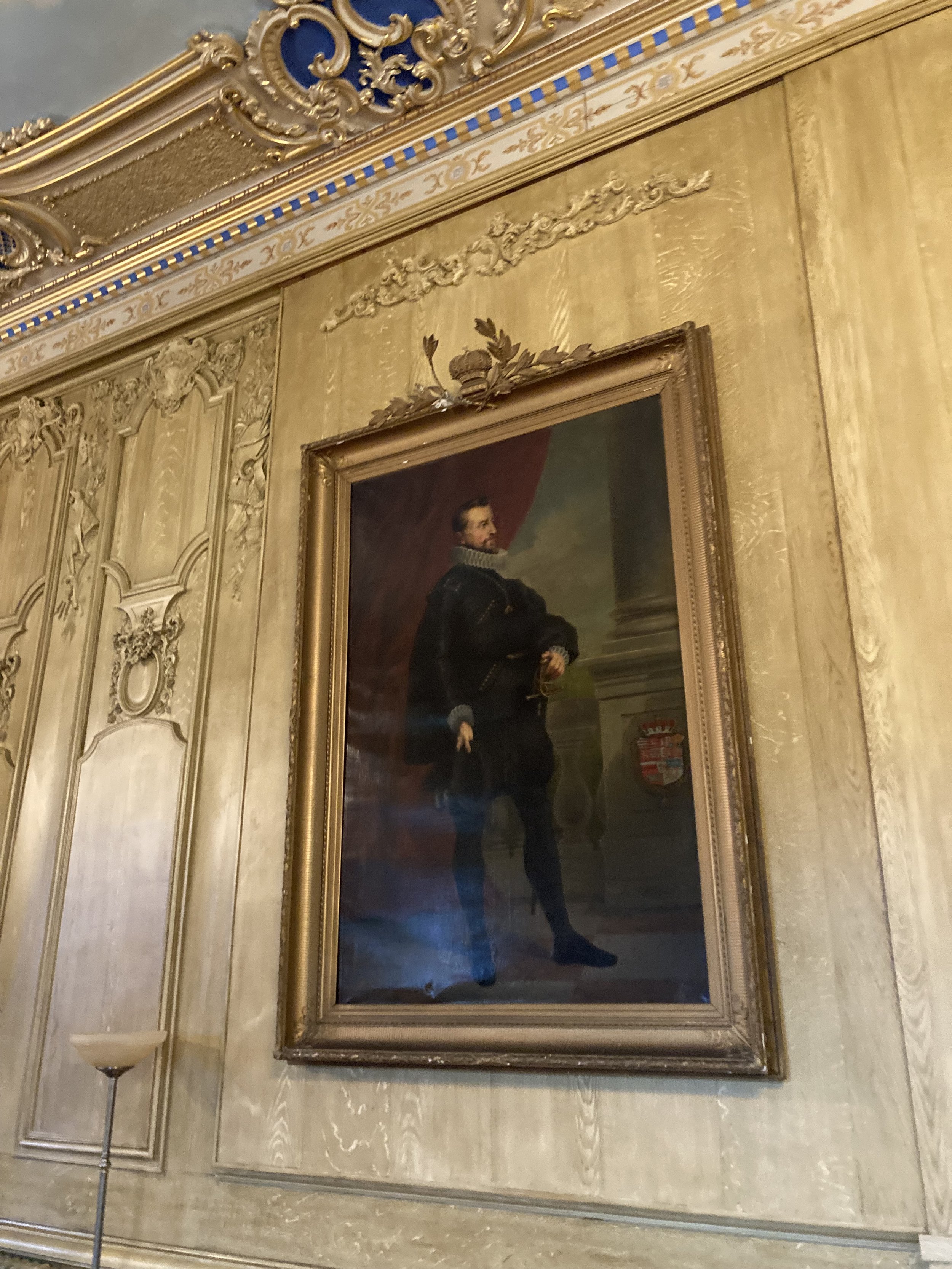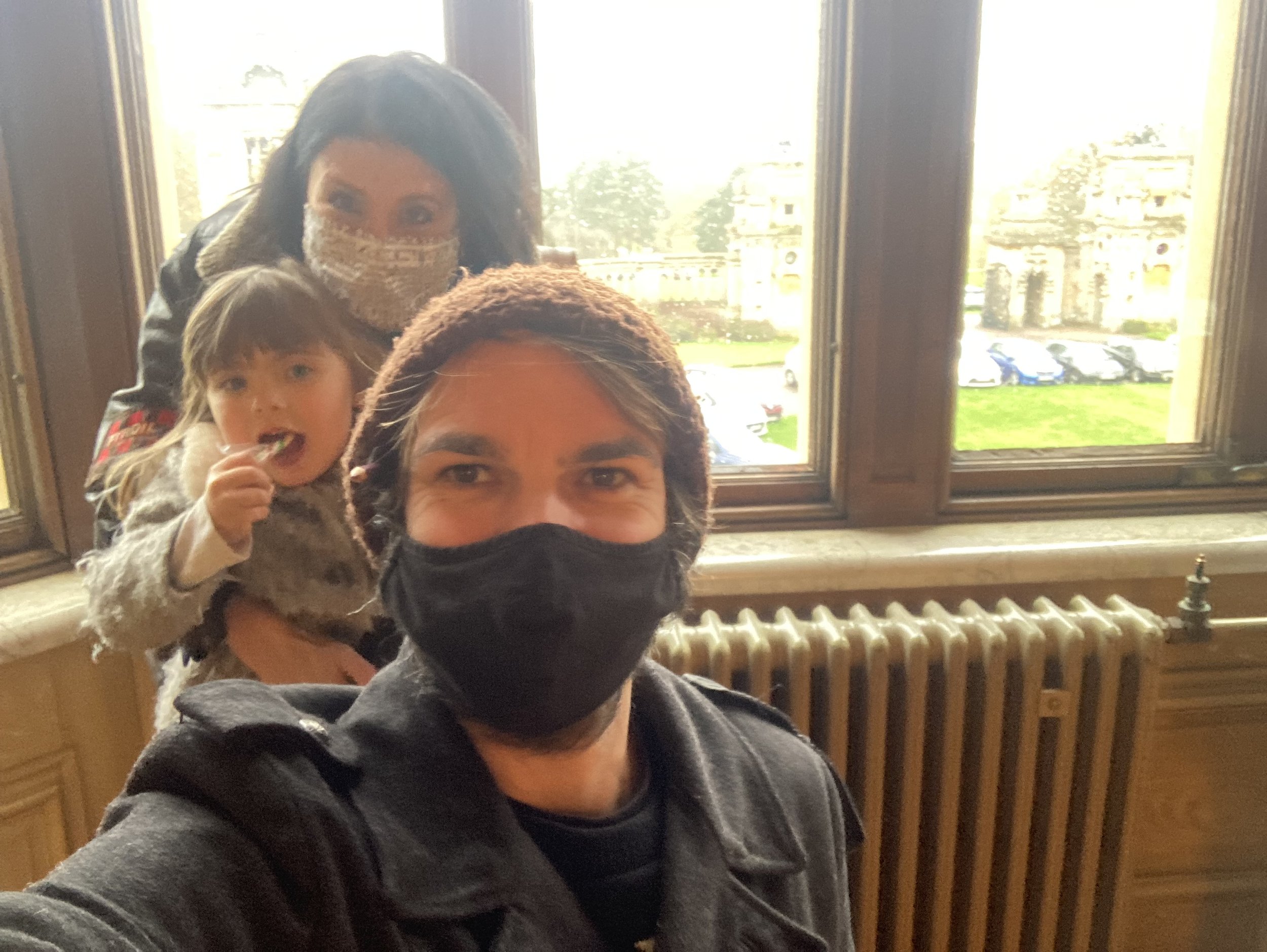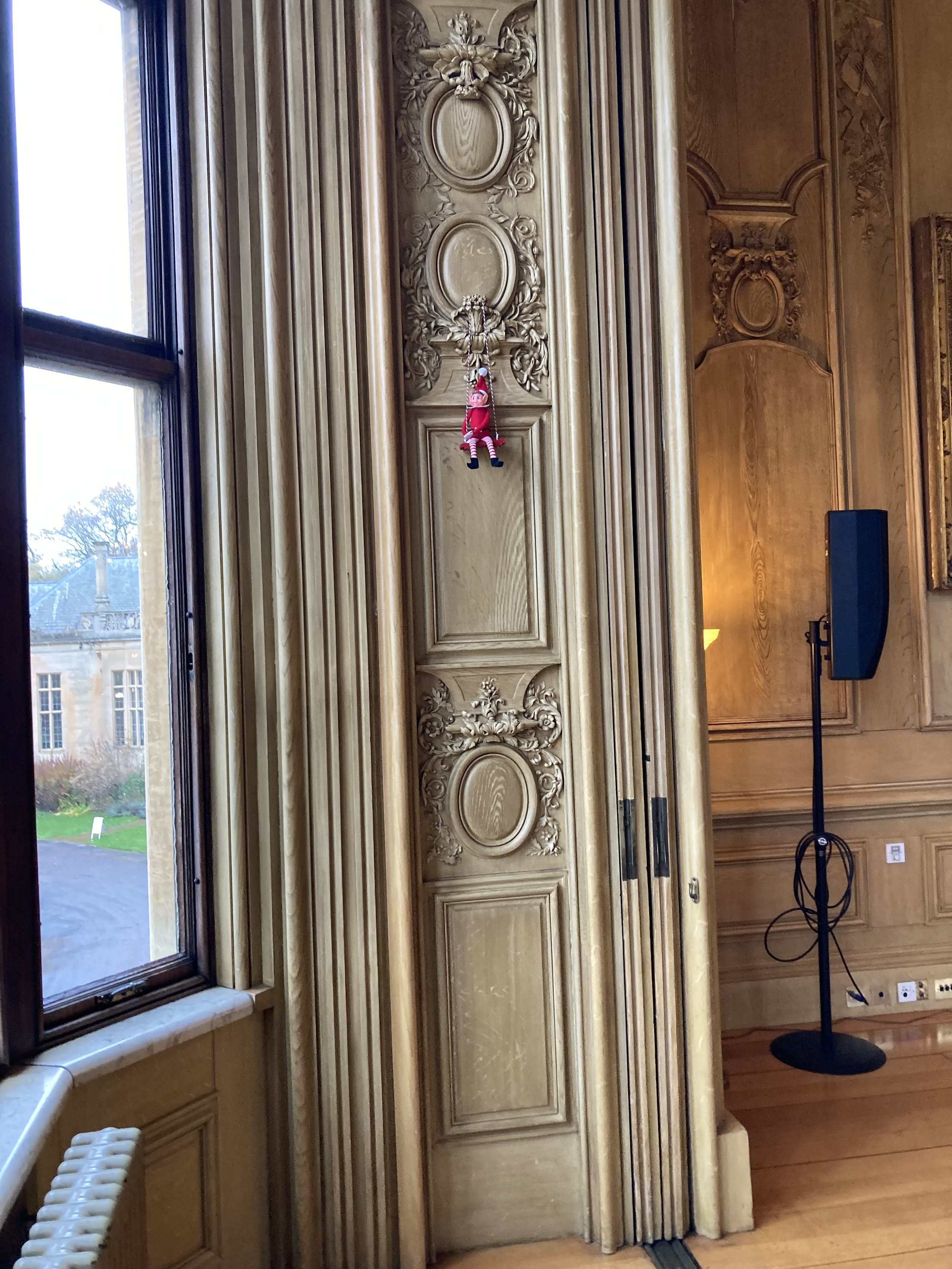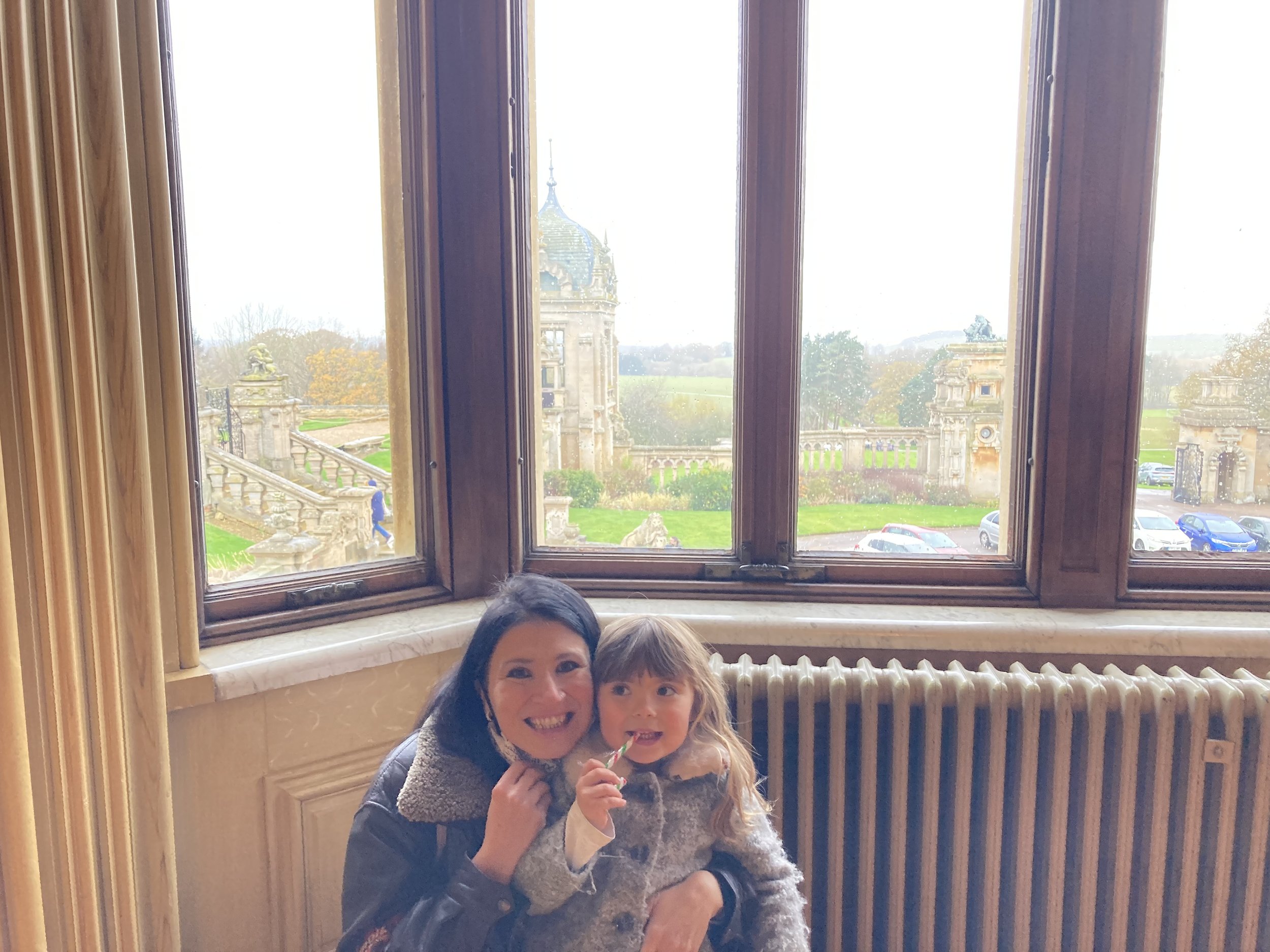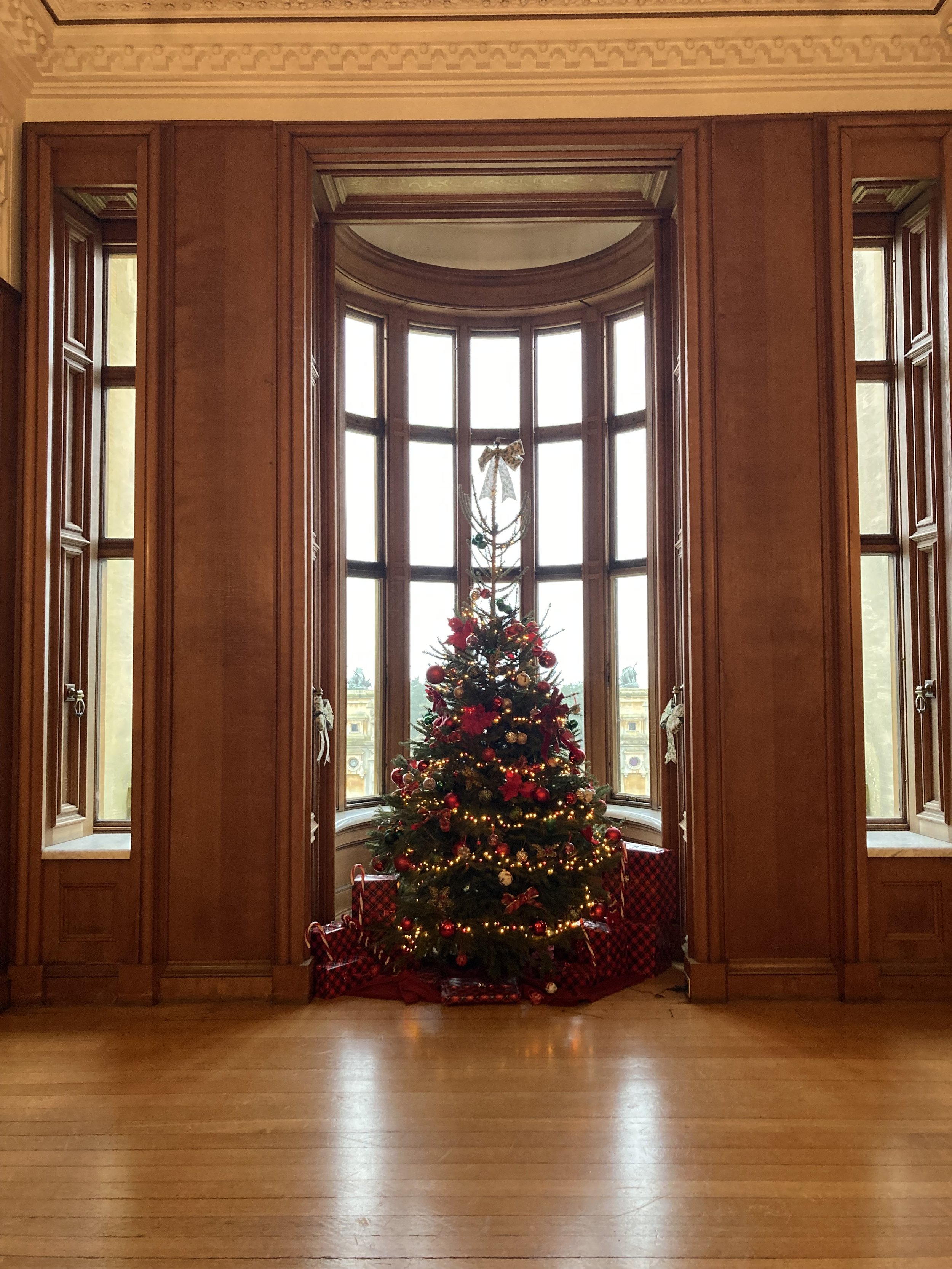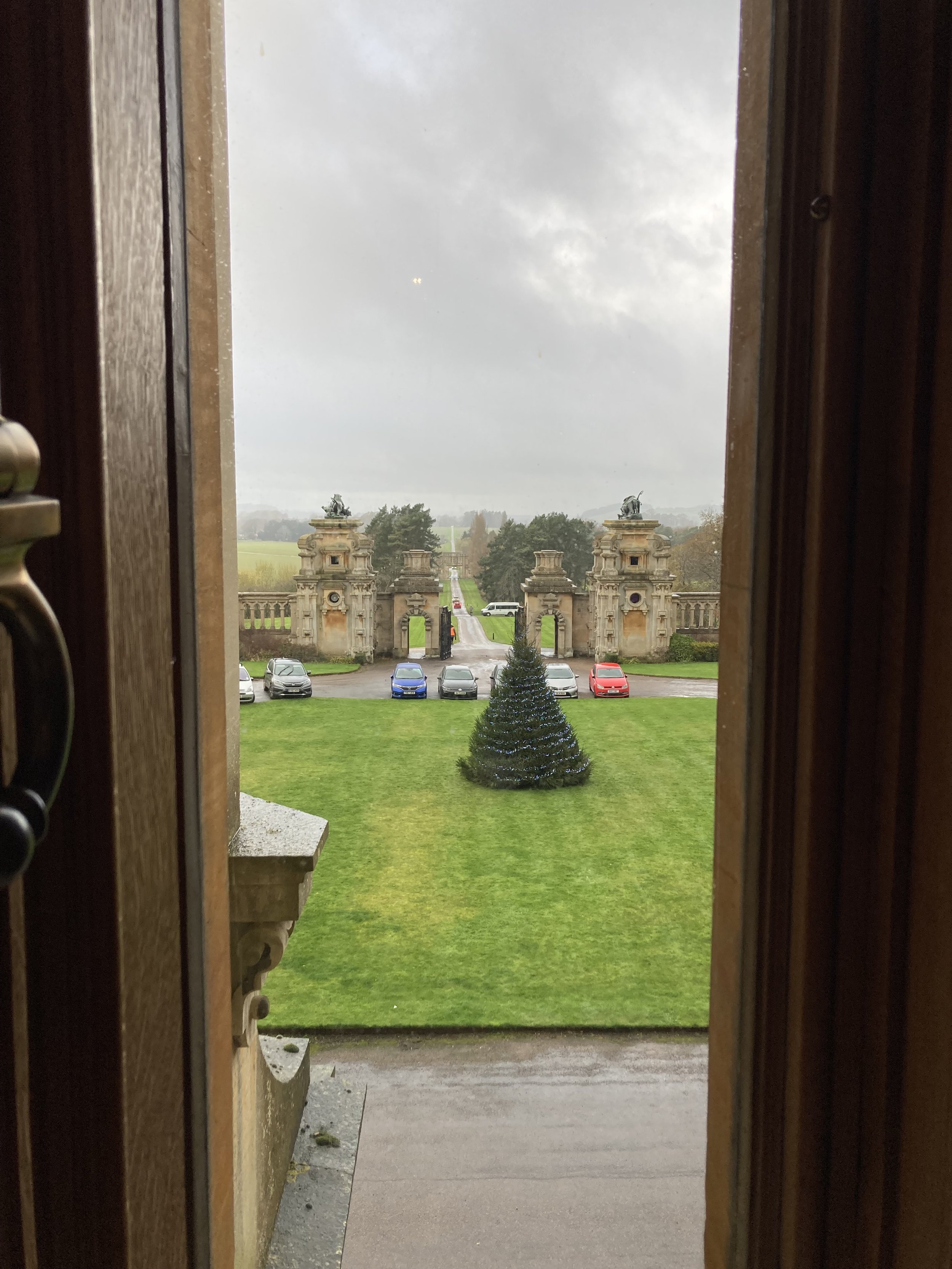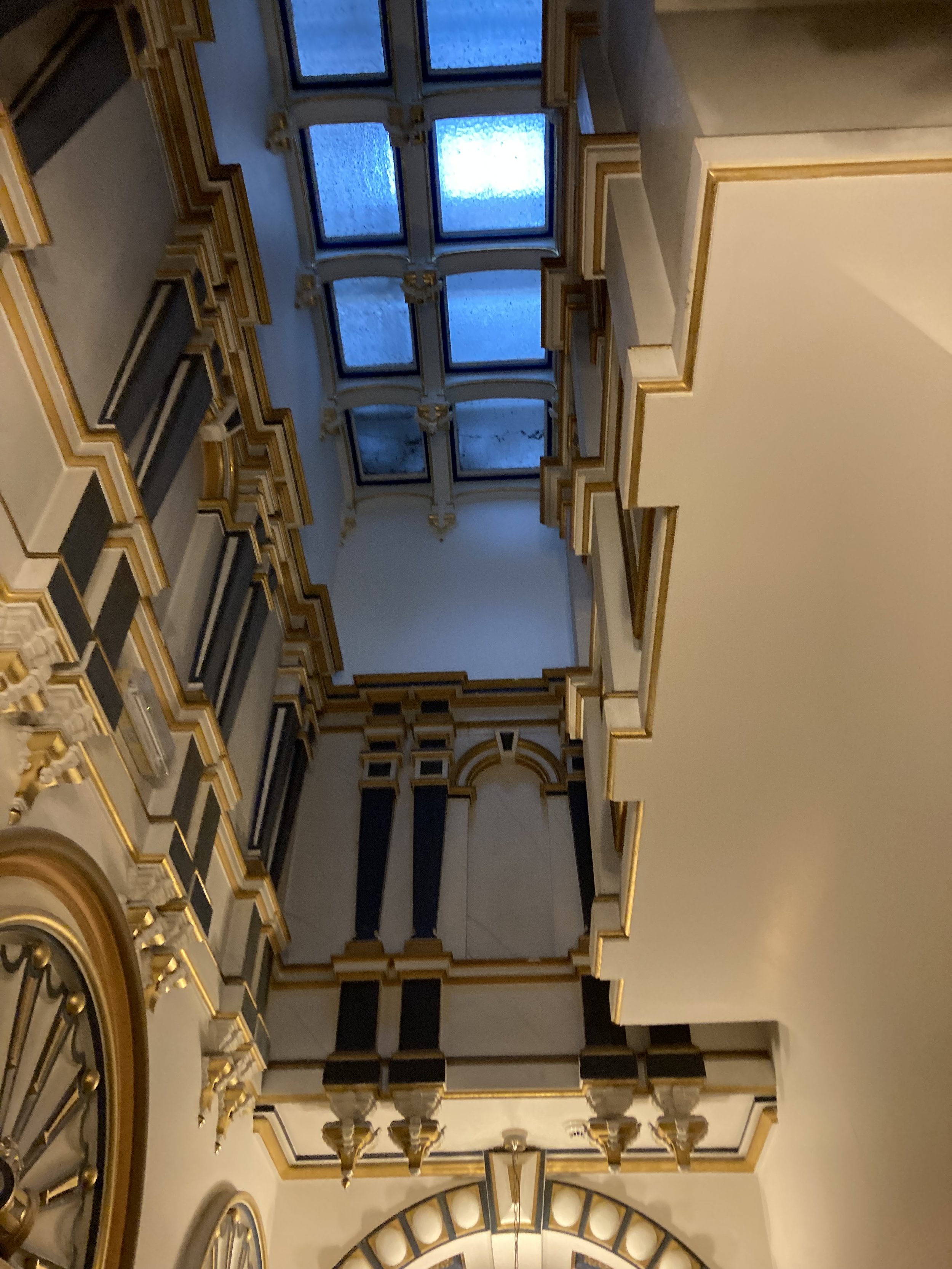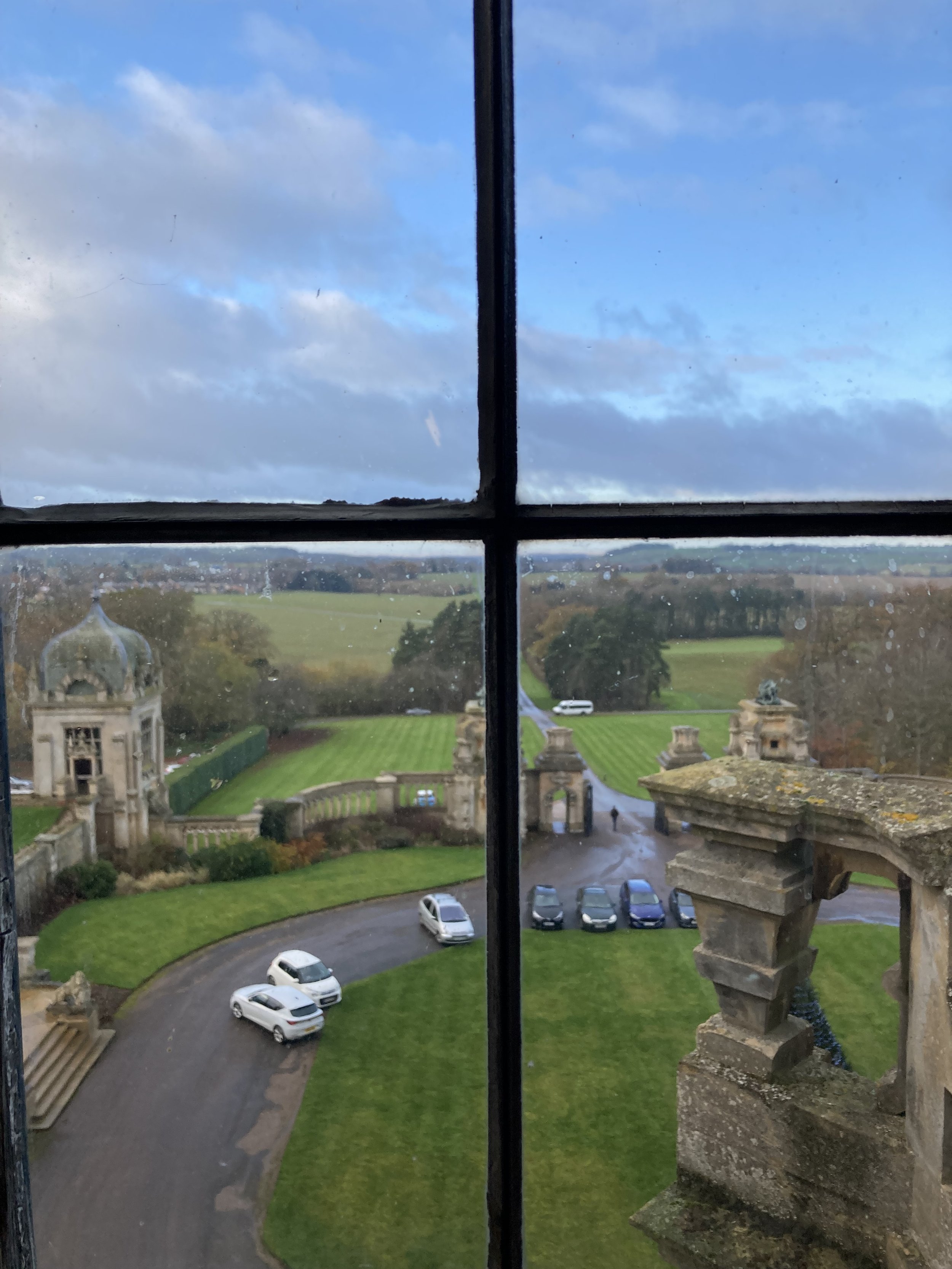You might ask yourself what John of Gaunt, the Jesuits, a mysterious international businessman with more family aliases than a Superhero franchise, the first brushless shaving cream, the Sherriff of Nottingham and the very first American University campus in Britain have in common.
Well, I can tell you, the answer is Harlaxton Manor.
I must admit, until Emily Archaeomum applied for a position at the University of Evansville, I had never heard of their study abroad campus at Harlaxton Manor, nor indeed Harlaxton Village. Emily was successful in her application, and so off we went to explore an estate steeped in intrigue, majesty and some rather confused chronologies.
Harlaxton sits on the outskirts of Grantham in Lincolnshire, a grand manor house surrounded by acres of gorgeous green countryside. As we arrived along winding country lanes, the splendour of the house rose into view, indeed an entire hillside had to be excavated in order for the impressive palace to be built. It is a remarkable architectural wonder, a traditional statement of elite residence, but not all was as it seemed.
The house has hints of Elizabethan architecture, but there is also Jacobean and Baroque in there, traces of continental influence are everywhere, a blend of stylistic treasures seamlessly forging a fashionable masterpiece. Yet the house is not as old as it first appears. I mean, it is pretty old, almost 200 years old in fact, but perhaps not as ancient as its image implies.
But we are getting ahead of ourselves. Audrey was here on business, the business of mystery solving, and this place was bursting with them.
We parked in the estate and walked up the grand driveway to the front entrance, all the while in awe of the enormity and splendour of this mansion. Stunning sculptures stared back at us from every precipice, lions, birds of prey, cherubs and I’m pretty sure we even spied a dragon.
Inside, things only got more decadent. The halls, corridors, state rooms and staircases are like something from a fairy-tale. Gold glittering fittings, shiny marble features, ornately carved wooden decorations, grand stone fireplaces and stunning antique furniture including some astonishing musical instruments. It was a little bizarre to see so many students dashing around such a place. Areas which are often only witnessed from behind rope barriers are simply the regular furnishings of this functional facility.
Of course, any building of this grandeur is guaranteed to contain a wealth of history and some fascinating stories. At Harlaxton though, the tales do not simply involve kings and knights, aristocrats and lavish elite living.
So, let’s start from the beginning. Harlaxton, as a place, is mentioned in the 1086 Domesday Book as Herlavestune, or Herelaf-Tun meaning the estate or farm of Herelaf. Before the current centrepiece was erected, another Harlaxton Manor existed. This Moated Manor house, which was situated closer to the current village, was built in the 14th century and is said to have been used as a hunting lodge by the infamous son of King Edward III and buddy of Geoffrey Chaucer, John of Gaunt.
The property and estate went through several hands before being purchased by the De Ligne family in the 17th century with whom it remained for some time. Things now begin to get interesting as our first curious rogues enter the fray. When Daniel De Ligne, High Sherriff of Lincolnshire and Knight of King James I, passed the estate to his son and then on to his grandchildren, the natural direct lineage of this family ceased. With no further children it seemed uncertain who would inherit the property.
Enter one George Gregory.
George Gregory was the De Ligne family lawyer. It appears Gregory somehow discovered the closest heir apparent, a descendant of Daniel De Ligne’s sister by the name of Anne Orton. Having made such an important discovery, Gregory conveniently married Anne and became the Lord of Harlaxton Manor and later even the Sherriff of Nottingham. Smooth.
Now, here is where the names begin to get a little ridiculous, try to stay with me. The estate passed to George Gregory’s son, George De Ligne Gregory. He had a brother called William Gregory, who changed his name after inheriting a family estate from his grandmother, Susanna Williams. So, William Gregory Williams (right??).
With no children himself, George De Ligne Gregory left Harlaxton to his nephew, the son of William Gregory Williams. This son, Gregory Williams (seriously?) also inherited his own father’s estate but took his uncles title with the inheritance and became, wait for it, Gregory Gregory (???).
Now I admit, I may have got that wrong, I got dizzy just typing it, but we can now move on to the next curious character in Harlaxton history, and the founder of the modern manor house, Gregory Gregory.
Only a little is known of this elusive figure. He appears to have attended Christ Church College, Oxford at age 19 where he studied Classics, Greek philosophy and Mathematics. He joined the local militia and became a Lieutenant Colonel in 1813. Interestingly, he may well have been involved in the Napoleonic Wars, mirroring the battles fought in France by John of Gaunt centuries earlier. He became a fellow of the Royal Horticultural Society in 1825 and of the Zoological Society of London in 1831.
Gregory Gregory seems to have had an appetite for foreign art and in the aftermath of the wars in France he, like many other English aristocrats, amassed quite a collection of French furniture and artworks from Paris. His next move following three years in France and Italy attached to certain embassies, was to build a home for his vast array of new acquisitions.
Harlaxton Old Manor had been sitting vacant and dilapidated for almost a century by the time Gregory Gregory inherited the estate, along with coal mines, canal and rail companies, considerable property across the midlands and a small fortune. Gregory had the Old Manor house pulled down, only the Balustrade’s, an Iron Gate and some curious Griffin statues were reused in the new build, though there are rumours that some marble interior floors are relics of the ancient dwelling. The architect hired to design the new look Harlaxton, Anthony Salvin, was commissioned to sketch the old Manor before it was pulled down. Had he not, there may have been no visual record of this incredible ancient residence.
A hillside was excavated, and Harlaxton Manor rose majestically onto the landscape. What a creation it was. Though Salvin is credited as architect, Gregory was probably responsible for the mix of architectural styles and perhaps even some of the layout. He would not live to see Harlaxton completed though. Despite overseeing the construction and being instrumental in many of its quirky curiosities, Gregory Gregory died of gout complications in 1854. He left a substantial gift in his will to his “confidential servant” Samuel Baguley. Samuel was named prior to anyone else, indicating an unusual level of importance for a butler. What I wonder, did Samuel have intimate knowledge of?
The intrigues of Gregory Gregory continue. The only known portrait of the secretive international businessman, disappeared under mysterious circumstances. His only remaining contemporary likeness is a profile carved into the ceiling. Secrets and curiosities seem to surround this unusual figure.
Following his death, the estate bounced around a number of not-quite family members. It was used as military barracks and training facilities during the first world war and continued as a home until eventually it was put up for sale in 1937. Had it not been purchased, the Manor was set to be demolished, but it was rescued by arguably Harlaxton’s most fascinating resident, Violet Van Der Elst.
Violet deserves a book of her own, in fact I believe there have been books written about this astonishing character. An eccentric self-made millionaire, entrepreneur, social campaigner and claimed descendant of Sir Guy Gundry, an Elizabethan Sea Dog, Van Der Elst was instrumental in the abolition of the death penalty in Britain. She also invented the first brushless shaving cream. One of the most unusual aspects of her life though, was her obsession with the world of the occult.
Violet had been interested in the supernatural long before her purchase of Harlaxton Manor, but now she had a perfect platform for her experimental attempts to explore the realms beyond our own. Harlaxton was rumoured to house several disturbed spirits. A spectral grey lady was often seen walking along the blue corridor during the night, and there had been a well engrained story of a De Linge baby, prophesised to die before a month old. A nanny had been ordered to keep constant watch and care of the child. She had been so overworked that she fell asleep from exhaustion. As she slept, the baby fell from her arms and into a fire. Baby’s screams and muffled cries have frequently been heard throughout the vast corridors of the eerie mansion.
Despite the abundance of ghostly occupants, it was her own husband with whom Violet wished to connect. John Van Der Elst, a Belgian artist, had died years earlier from a ruptured ulcer and Violet had been devastated by the loss. Apparently, his ashes can be found still, in an urn in the entrance hall where Violet placed him decades ago. Mourning him would not be enough. Violet converted the old library at Harlaxton into a room in which to conduct seances. With the windows draped in dark curtains, the space adorned with pitch black furnishings and herself dressed head to toe in midnight black garments, she tried every means possible to contact the spirit of her dearly departed love. It is not clear whether she managed to reach John, but the intensity of unexplainable occurrences at the Manor seems to have wildly increased following her exploits.
Violet Van Der Elst gave up on Harlaxton after the Second World War and sold the property to the Jesuits, who converted the house into a Noviate. She died in 1966 but perhaps her legacy remained with the house she once occupied.
Multiple occurrences of a woman in black robes or a black dress have been seen around the house, footsteps are frequently heard in the halls, yet no one can be seen. Loud bangs and screams are regularly witnessed from empty rooms and corridors. The scent of cigar smoke has been witnessed in the old servant quarters, doors and furnishings are said to open and close of their own accord, vases have been seen levitating, objects moving by themselves. Many residents have mentioned a feeling of being followed through the manor despite knowing they were alone, and glimpsing strange forms of figures where there were none. A number of occupants in a particular room at differing times admitted to suffering terrible nightmares and waking up to see a subhuman face close to their own, or a creepy dark robed figure hovering in the room.
It is said that when the Jesuits purchased Harlaxton Manor, there were such an abundance of unexplainable disturbances that they had to conduct severe exorcisms of the property. Shrieks were heard bellowing from the chimneys, but the hauntings appear to have continued even after the Jesuits eventually sold the property in the 1960’s.
So why do I mention these strange folk tales you ask. Well, curiously, during Emily’s first stay at Harlaxton, she was given a bedroom beside Violet Van Der Elst’s old library. That night, the room was terrifying, it was so bad Emily booked into a nearby Travelodge. Later she would learn that she was not alone in her inability to remain in the room, many had suffered the same issue, but only there in that specific part of the house. In another rather bizarre experience, we visited the library and witnessed the piano play two notes entirely by itself, no one close enough to have touched the keys. An electric bin is also known to be active in the library, without human intervention. Perhaps these occurrences are caused by a surge or electrical fault (it is an electric piano) or perhaps…
The next day I even noticed a number of scratches on my back which I cannot explain, though they may simply have been from an over excited 4-year-old who needs her nails clipping a bit.
Whatever the cause, you have to admit, despite its relative youth, Harlaxton is fascinating. The history of Harlaxton is filled with riddles, secrets and seances. I haven’t even begun to discuss the mysterious interiors, secret passages and doorways, four of the seven deadly sins depicted in marble, multiple images of Hercules, tapestries and art depicting mythical tales, trojan heroes, saintly sorcery, foreign idols, fantasy creatures and more. At the summit of the Cedar staircase, a statue of Father Time is depicted with a genuine scythe and the floor plans of Harlaxton Manor in his hand. What does all this symbology represent, is it the random collections of eccentric owners, or is something hidden amongst these symbols, is there a deeper meaning? Could there be a reason why Gregory Gregory built the Manor in the way he chose, or why Violet Van Der Elst believed she could contact the dead and immerse herself in the occult here? We have not even begun to explore the vast gardens and estates, but a glance at the OS map shows curious features, springs and wells, caverns and forests, hills and streams. Ancient occupied landscapes revered the site long before either Manor House was conceived. It is surely no coincidence that a frequent visitor to the Manor was Mrs Hargreaves, previously known as Alice Liddell, the real-life model for Alice in Wonderland!
This was the reason Audrey was so keen to explore, these were the questions that drove her to run around the rooms, feet clapping against the polished wooden floors, a maniacal possessed grin on her face as she experimented with the varying echoes produced by high ceilings with ornate plaster work. There are many mysteries inside and out of this incredible architectural feat. Fortunately, we have some time to get to the bottom of them. Down the rabbit hole we go.
We will be sure to keep you updated on our progress.
As the sun fell beyond the tree lined hilltops, we bid a temporary farewell to Harlaxton Manor and watched it disappear in the rear-view mirror. We truly were awestruck by its beauty. A stunning, strange architectural masterpiece so inspired and affected by common continental influence yet perfectly nestled in a beautiful English countryside setting.
From our Archaeofam to yours,
Goodnight.

